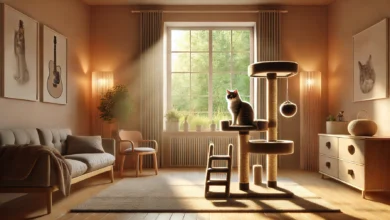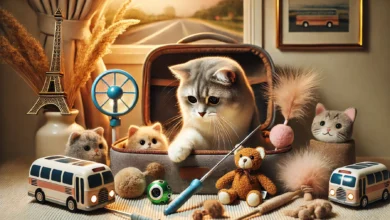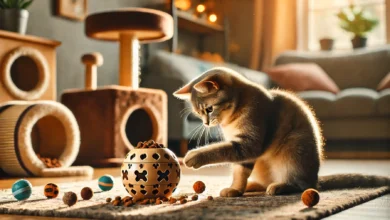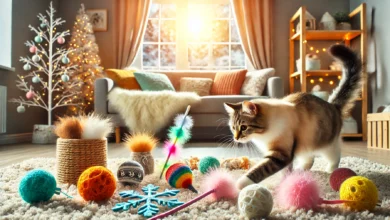Understanding the Safety of Toys for Cats
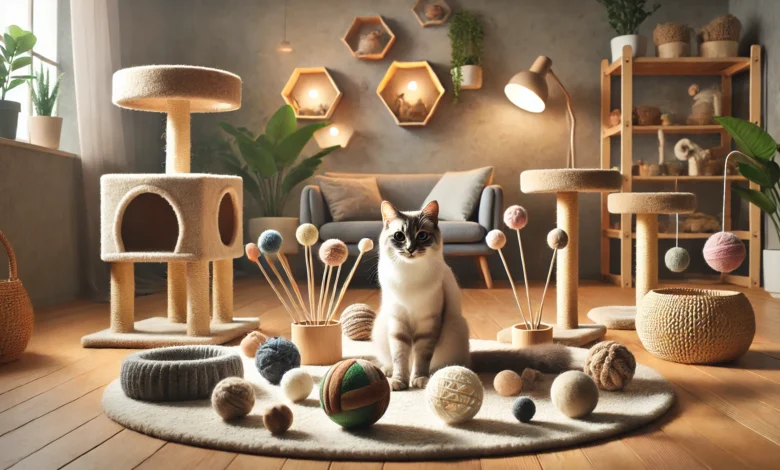
Cats naturally have an innate curiosity and love to play.
Whether chasing a ball of yarn or pouncing on a squeaky mouse, toys are an important vehicle for keeping your cat both entertained and mentally stimulated.
But as a responsible cat owner, you want to make sure the toys you provide are not only fun but also safe for them.
The safety of toys is essential in determining whether your cat can avoid accidents, injuries, and even health risks.
In this article, we will cover the elements that make a toy either safe or unsafe for your cat.
These factors will assist you in making proper decisions so that your pet remains happy and secure.
As much fun as it might be to watch your cat at play, it’s incredibly easy to miss some of the hidden dangers in the toys we give them.
Using unsafe toys can lead to accidents, choking hazards, or the ingestion of hazardous materials.
Let’s explore why safe toys are so important for your cat.
Table of Contents
Why Toy Safety is Important for Cats
Keeping your cat safe during play is not only about preventing minor injuries.
The toys you choose can make a huge difference in your cat’s overall health and well-being.
Just like we carefully choose safe products for ourselves, we should do the same when picking out toys for our pets.
The safety of toys means protecting your cat from unnecessary risks while still allowing them to engage in the playful behaviors they need and enjoy.
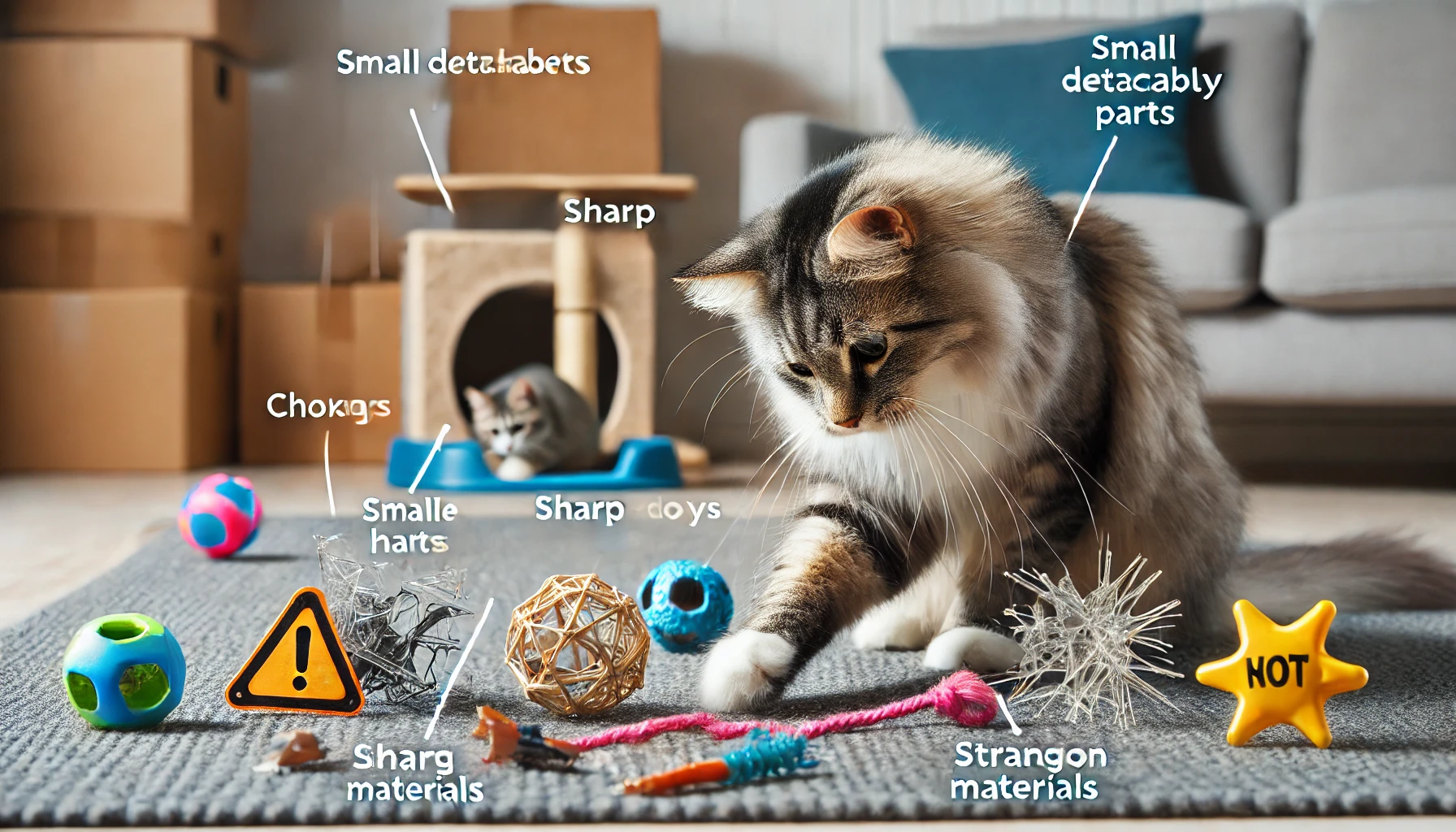
Potential Dangers of Unsafe Toys
Unsafe toys may present several dangers to your cat, ranging from physical hazards to long-term health risks.
For example, toys with small parts that can easily detach may become choking hazards.
Fragile toys can shatter and create sharp edges that might harm your cat’s paws or mouth.
- Choking hazards from small pieces
- Sharp edges or broken toy fragments
- Exposure to toxic materials, such as certain plastics or chemicals
- Strangulation risks from long strings or wires
While these hazards may seem unlikely, they can happen when we least expect them.
It’s always better to be cautious and select safe toys to ensure your cat’s safety during playtime.
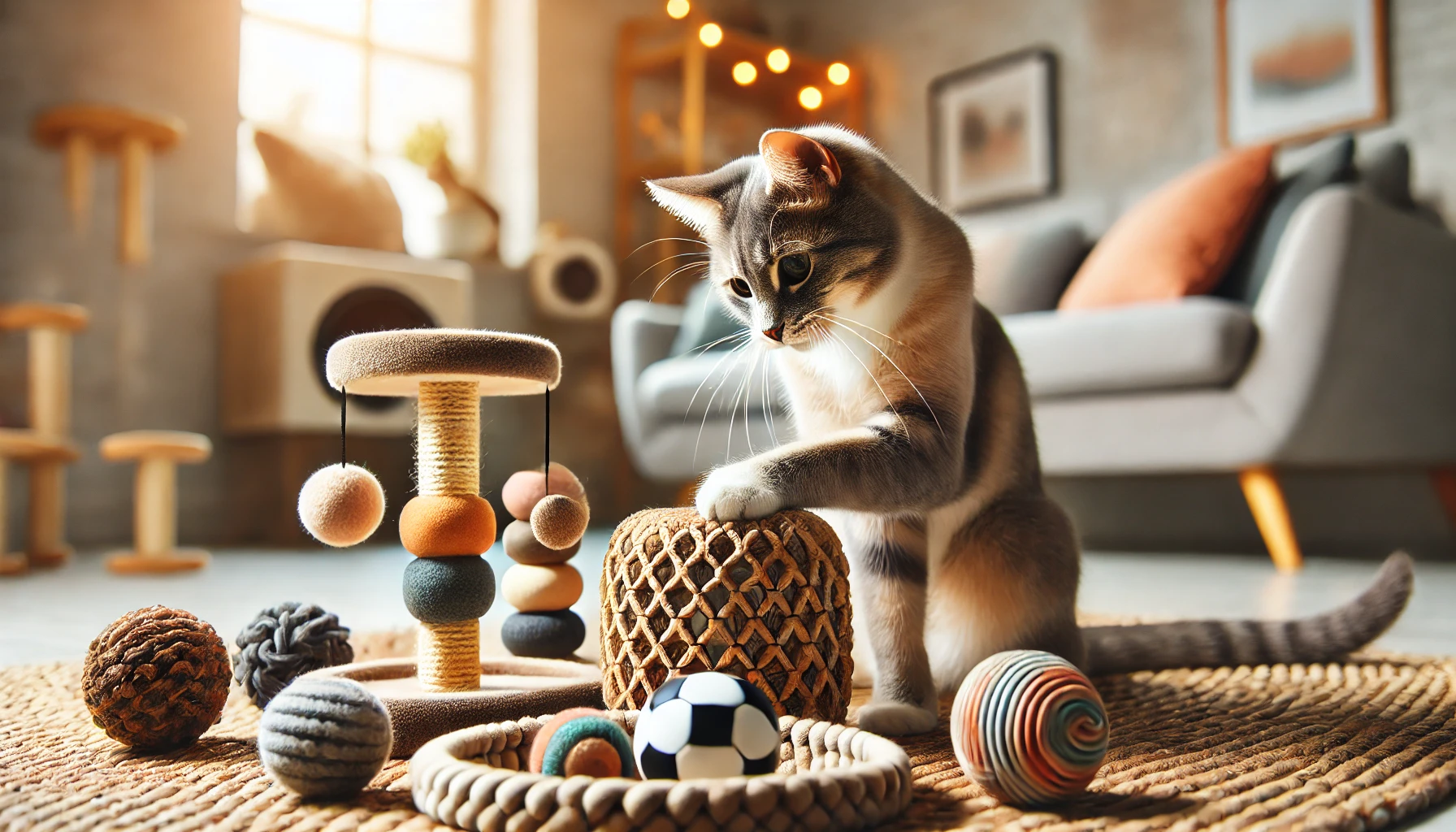
How Safe Toys Ensure Your Cat’s Health
On the other hand, safe toys can enhance your cat’s quality of life.
When your cat feels safe while playing, they are more likely to engage in natural behaviors like chasing, pouncing, and chewing.
Safe toys encourage mental stimulation and physical exercise, which are essential for maintaining your cat’s overall health and happiness.
Safe toys also help reduce the development of stress-related behaviors.
Cats that are stressed or bored may develop undesirable habits, such as scratching furniture or chewing on inappropriate items.
By providing your cat with safe toys, you help them stay relaxed and comfortable, preventing unwanted behavior.
The safety of toys not only ensures your cat’s entertainment but also supports their emotional well-being.
After all, the saying holds true: A happy cat is a healthy cat!
Ensuring your cat’s toys are safe can help prevent injuries and maintain their health and well-being. Consider factors like non-toxic materials, durability, and appropriate size when choosing toys.
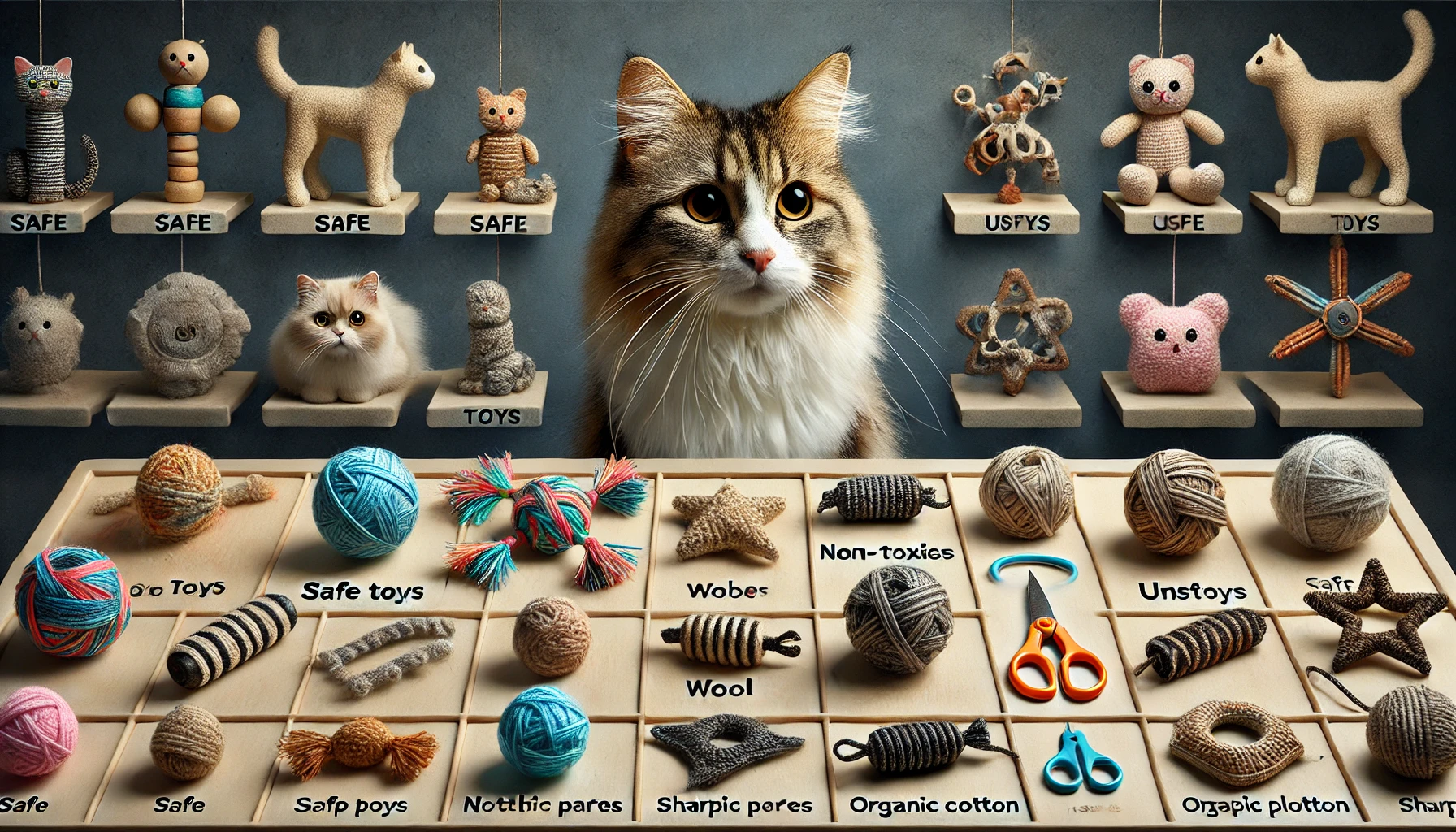
Picking the Right Toy: Common Risks of Cat Toys
Not all toys are created equal when it comes to the safety of toys for your feline friend.
Some of those fun and seemingly harmless toys may pose serious risks if they are not made with your cat’s safety in mind.
While many cat toys available on store shelves are safe, some carry hidden dangers that could cause injuries or health problems for your pets.
Understanding the common risks of cat toys will help you make more informed decisions.
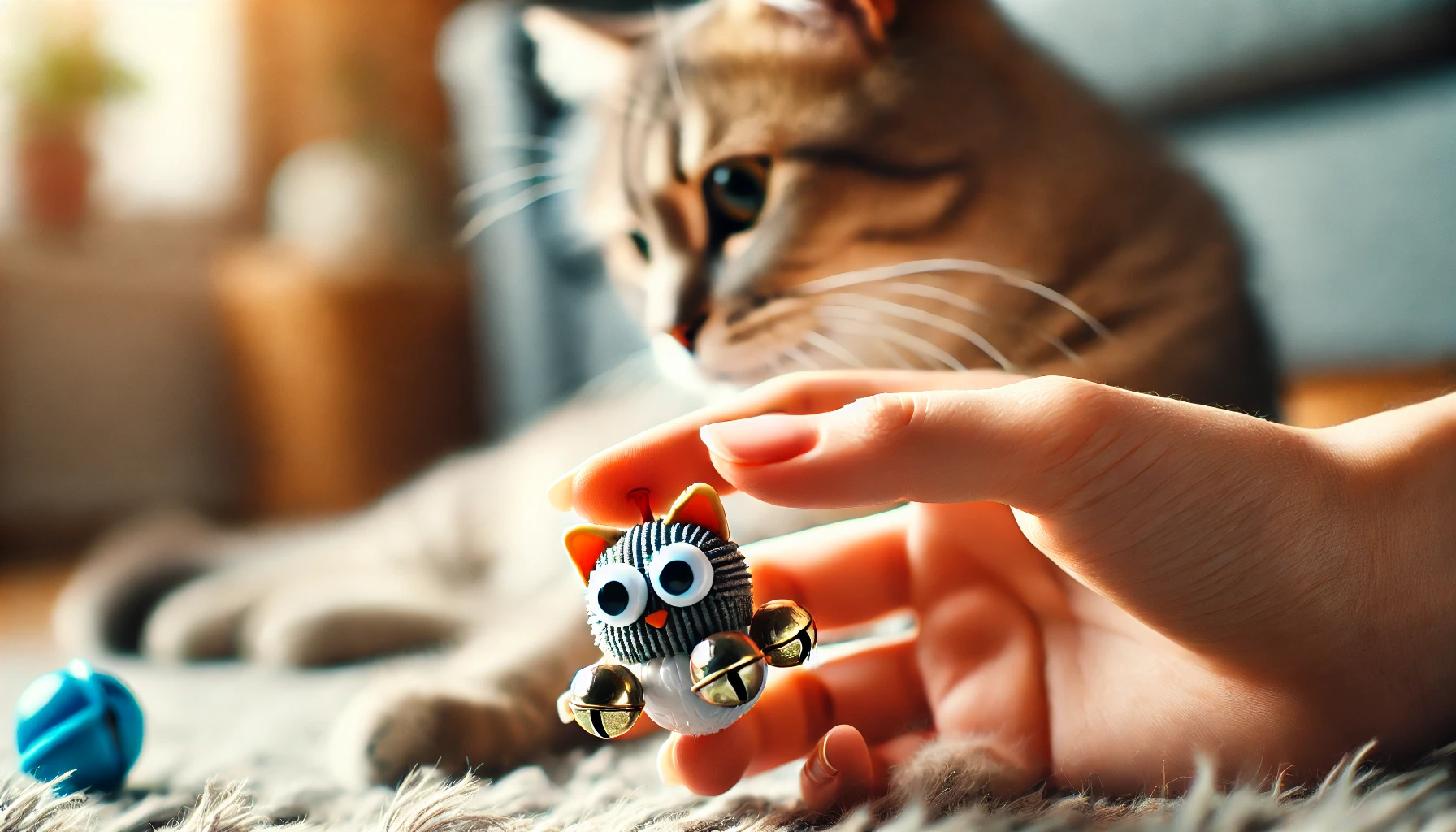
Choking Hazards
One of the most serious risks is choking, which can happen if a toy has small parts that can easily break off or be swallowed by your cat.
Many toys have small bells, feathers that could detach, or plastic eyes, which can turn dangerous if your cat ingests them.
Always inspect toys for loose parts that could pose a choking hazard to your cat.
It’s also important to supervise your cat while they play, especially with smaller toys that could be accidentally swallowed.
Favor larger toys or those without removable parts, which will decrease the potential for a choking hazard.

Toxic Materials Used in Cat Toys
Another concern is the materials used in some cat toys, as they may contain harmful chemicals.
Many cheap or poorly designed toys include dangerous substances such as phthalates, lead, or BPA, which are toxic if ingested or chewed.
Plastic toys, in particular, are often coated with chemicals that could be harmful to your cat over time.
It’s always best to seek out toys made from non-toxic, natural materials such as rubber, wool, or organic cotton.
Additionally, check for certifications that ensure toys meet safety standards to protect your cat from hazardous materials.
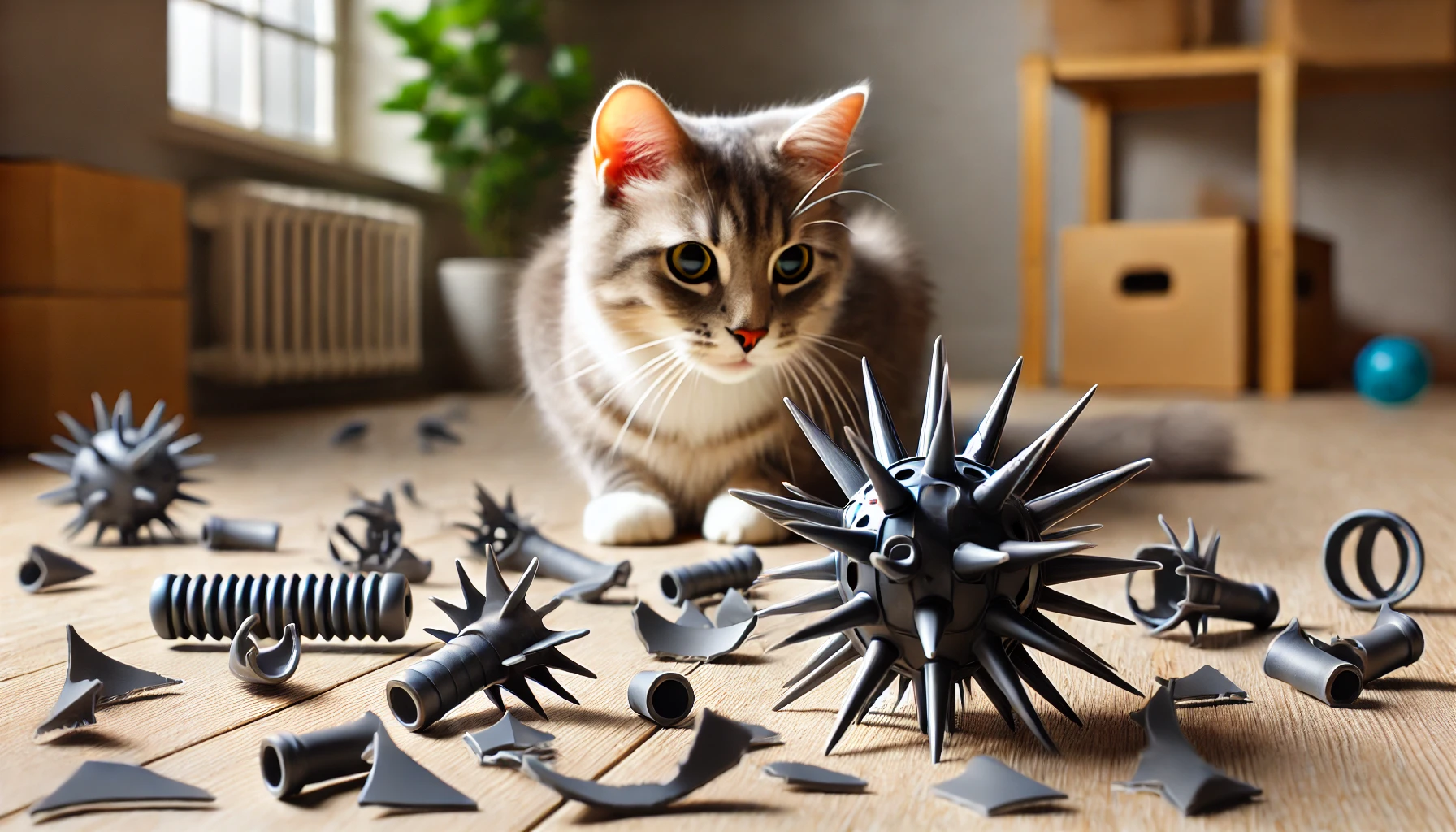
Sharp or Fragile Components
Toys with sharp edges or fragile parts can injure your cat, potentially causing cuts or even internal punctures if your cat bites or plays too roughly with them.
Glass or thin plastic toys may break into sharp shards, and poorly made toys can easily turn into dangerous fragments.
When selecting toys for your cat, ensure they are durable and free of sharp or fragile components.
Inspect your cat’s toys regularly and replace or discard any that show signs of damage to avoid accidents.
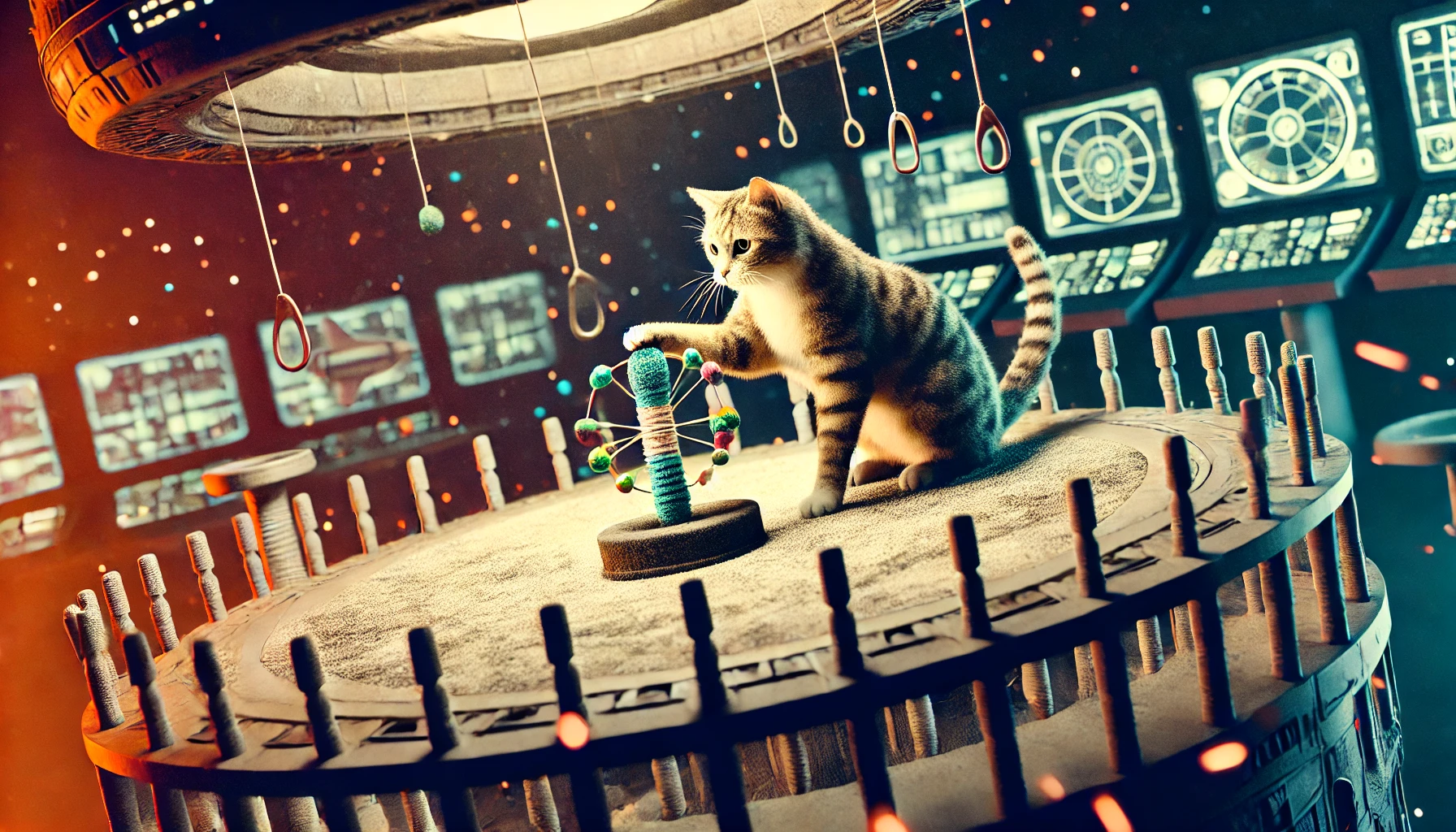
Incorrectly Sized Toys
Toys that are either too small or too large for your cat can also pose risks.
Toys that are too small may be swallowed or become lodged in your cat’s throat, while oversized toys may not provide the necessary interactive benefits.
For kittens and smaller breeds, it’s best to avoid toys with small parts that could be easily swallowed.
For larger cats, choose toys that are appropriately sized and provide enough engagement during playtime.
By staying aware of these common hazards and ensuring the safety of toys, you can make playtime safer and more enjoyable for your cat.
Choking hazards, toxic materials, sharp parts, and incorrect sizing are common risks with cat toys. Select toys made from safe materials and check for durability.
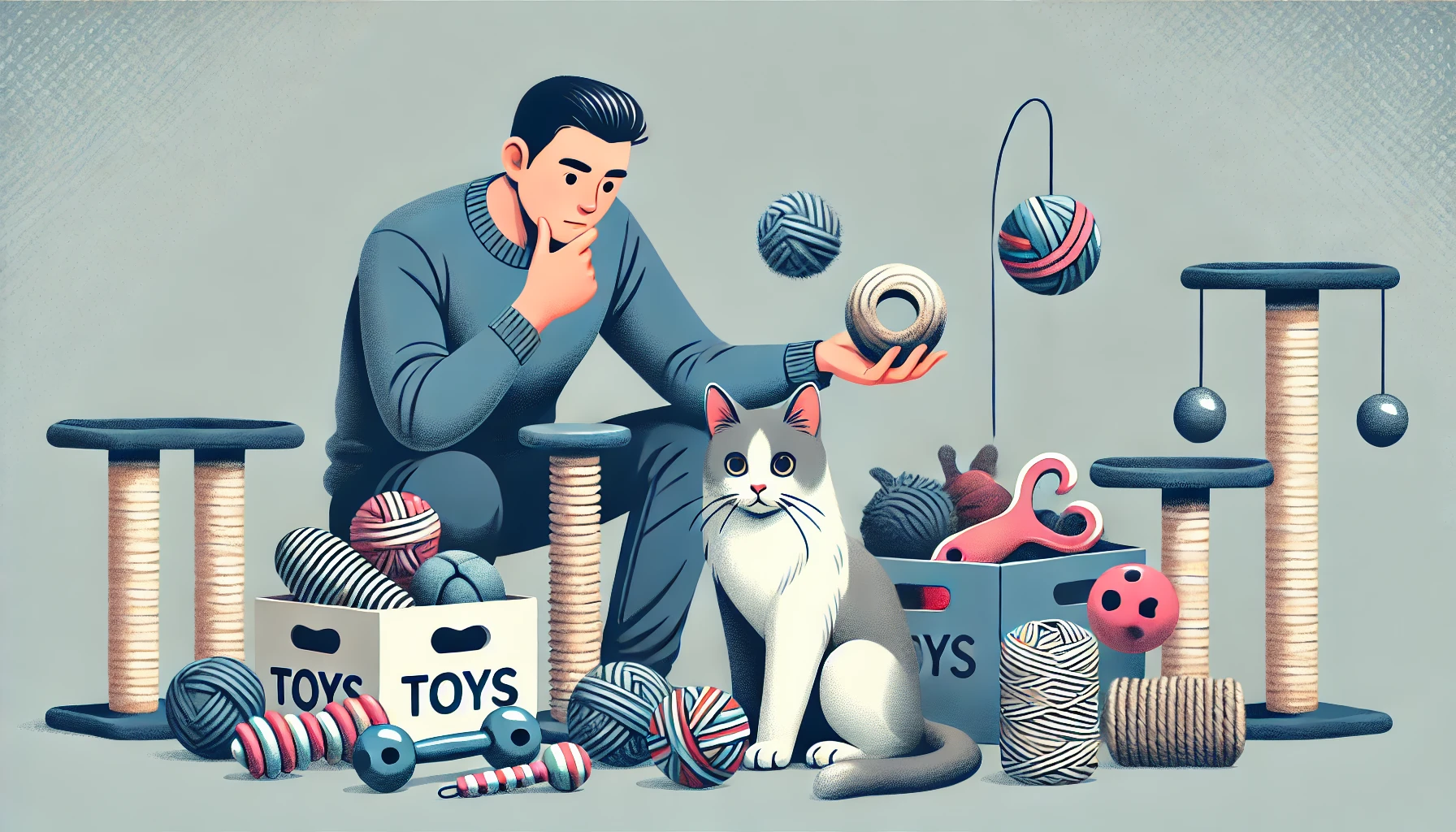
How to Choose Safe Toys for Your Cat
When it comes to choosing the best toys for your cat, safety must be a top priority.
While cats will play with almost anything, not every toy out there is considered safe.
By understanding the key factors that determine the safety of toys for your cat, you can ensure that your pet stays not only entertained but also safe from harm.
Here are simple tips to help you choose the best and safest toys for your feline friend.
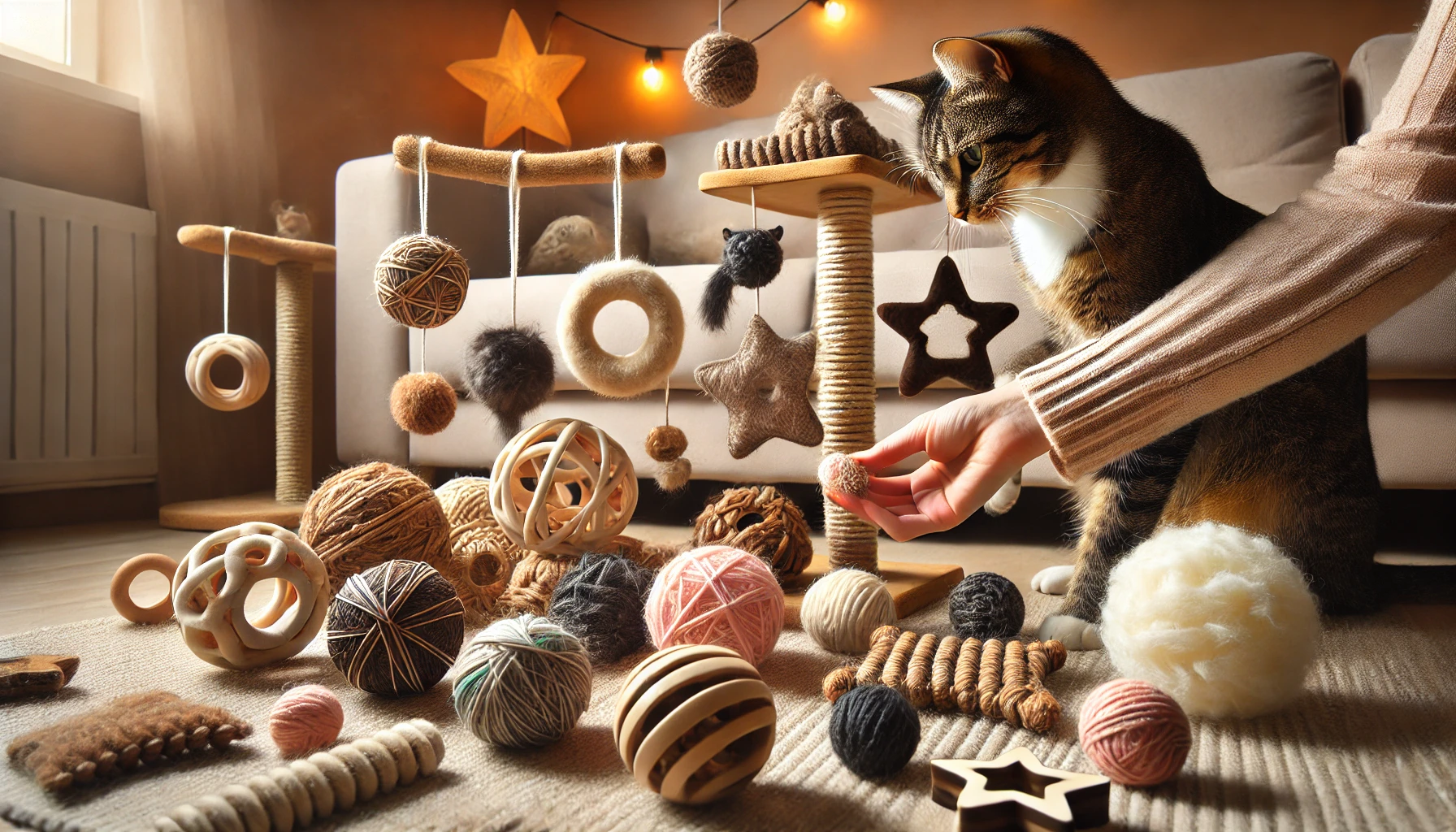
Material Safety
The safety of toys can be significantly improved by using higher-quality materials.
Look for items made from non-toxic and natural materials, such as rubber, organic cotton, or untreated wool.
Avoid toys that could contain toxic chemicals, dyes, or treatments, especially those made from cheap plastic or synthetic fiber.
- Rubber: Durable and non-toxic, rubber is ideal for chew toys.
- Wool or Felt: Natural materials that are soft on your cat’s teeth and claws.
- Organic Cotton: Organic cotton is free from harmful pesticides and makes safe, soft toys.
By selecting toys made with non-toxic, durable materials, you reduce the risk of exposing your cat to harmful elements, and the toys will last longer.
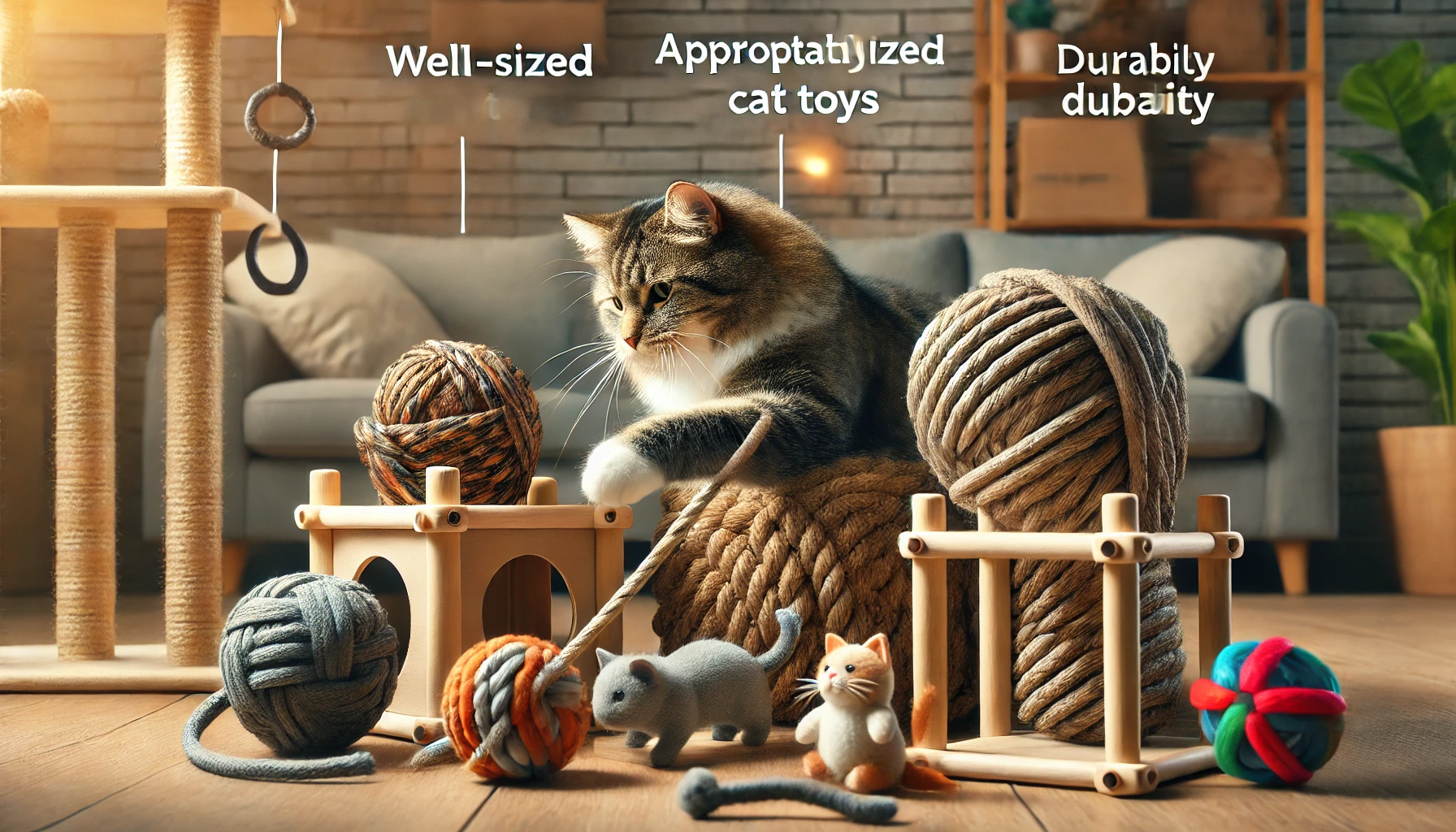
Size and Durability Considerations
The size and strength of the toy are crucial in ensuring safety.
A toy that’s too small can easily become a choking hazard, while a poorly constructed toy may break into sharp pieces that could harm your cat.
Always choose toys that are the right size for your cat’s breed and age.
- For Kittens: Look for larger toys that cannot be swallowed.
- For Larger Cats: Ensure that the toy is sturdy enough for rough play.
Additionally, toys must be durable enough to withstand chewing, scratching, and biting.
Sturdy toys made from rubber, heavy fabric, or thick rope are excellent choices for active cats.
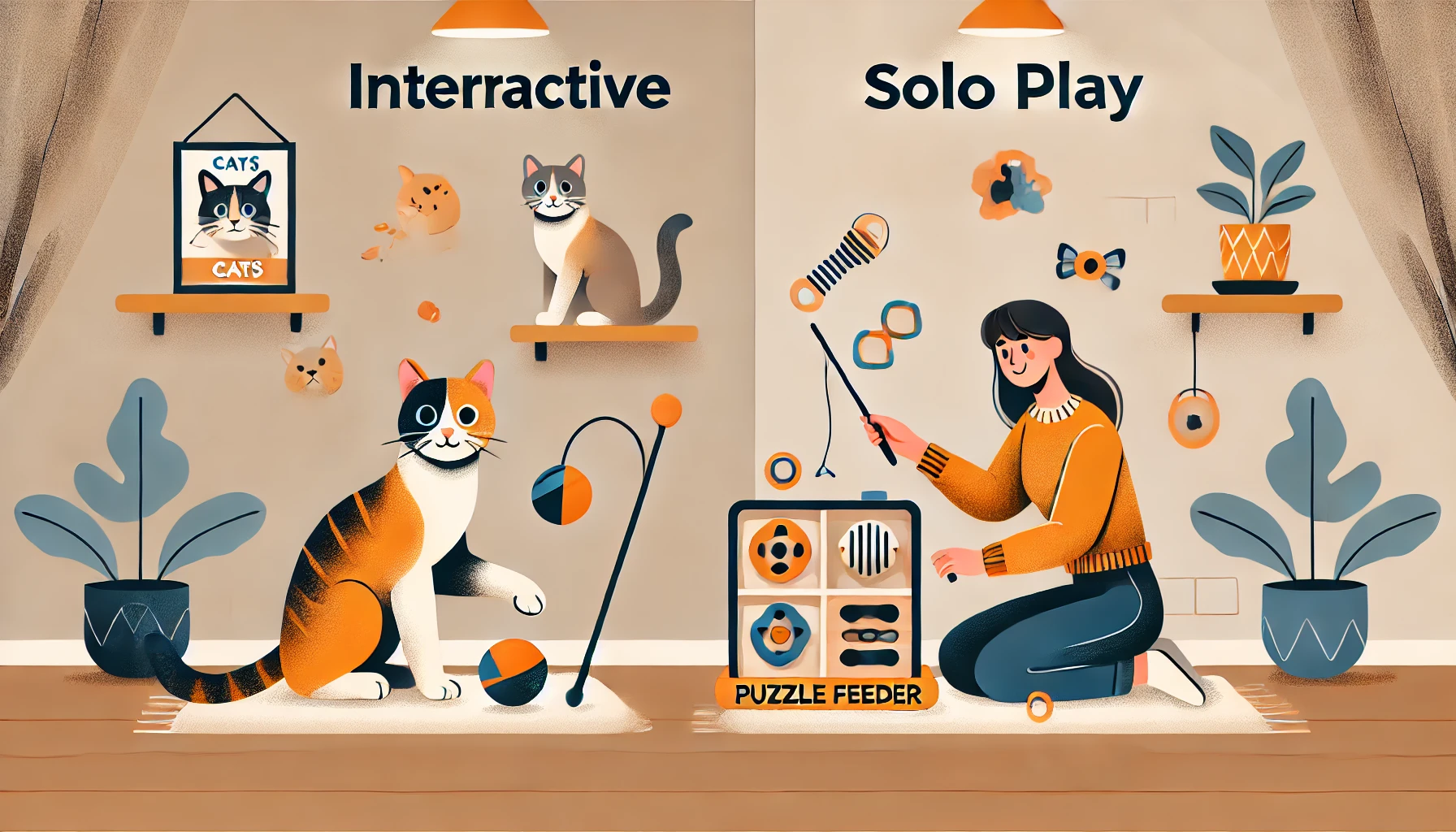
Interactive vs. Solo Play Toys
Not all toys serve the same purpose.
Some toys are designed for interactive play between you and your cat, while others are meant for solo play.
For interactive toys like wands, lasers, and string-based toys, ensure they are sturdy and don’t have small parts that could break off and be swallowed.
For solo play, select toys that are durable enough for unsupervised use.
Interactive toys are great for bonding and helping your cat get exercise, while solo toys keep your cat’s mind stimulated when you’re not around.
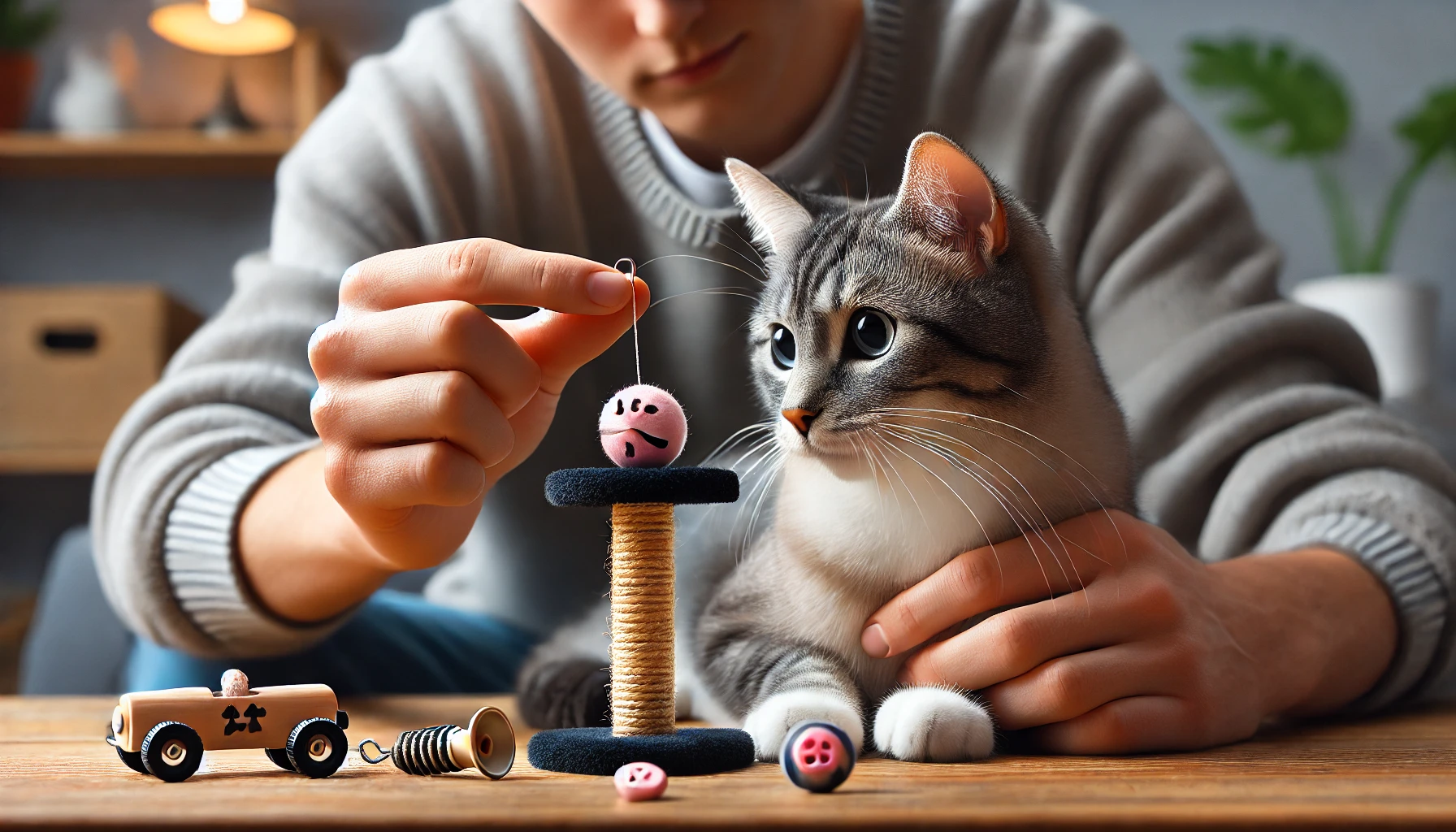
Checking for Loose Parts
Always inspect toys for any loose parts before giving them to your cat.
Small objects like bells, buttons, or eyes can easily come off during play and become a choking hazard.
Gently tug on any loose parts to make sure they won’t be torn off easily.
If a toy has many small parts or is poorly constructed, it’s best to avoid it.
Simplicity and solid construction are key when choosing safe toys for your cat.
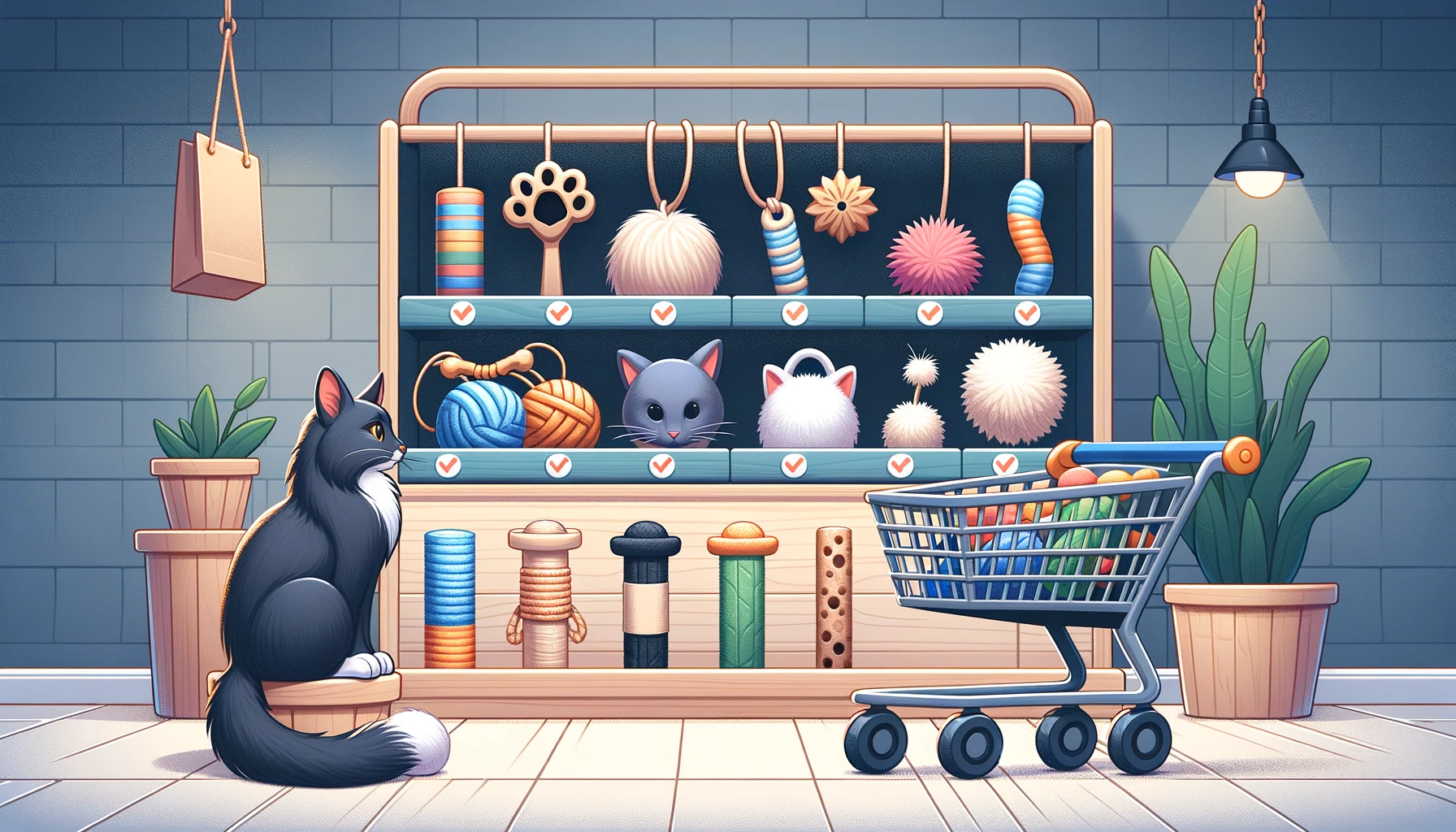
Safe Brands of Toys
Finally, consider purchasing toys from reputable brands that certify their products as safe for pets.
Many well-known brands undergo rigorous testing to ensure their toys meet safety standards, giving you peace of mind that the toys are free from harmful chemicals and designed with your cat’s safety in mind.
Look for certifications or labels indicating that the toy is non-toxic and safe for pets.
By choosing trusted brands, you can feel confident that your cat is playing with safe, high-quality toys.
By following these guidelines and focusing on the safety of toys, you can provide hours of fun for your cat without compromising their health and well-being.
To choose safe toys, focus on materials, size, and durability. Choose non-toxic options like rubber and organic cotton, and ensure toys are large enough to avoid choking hazards.
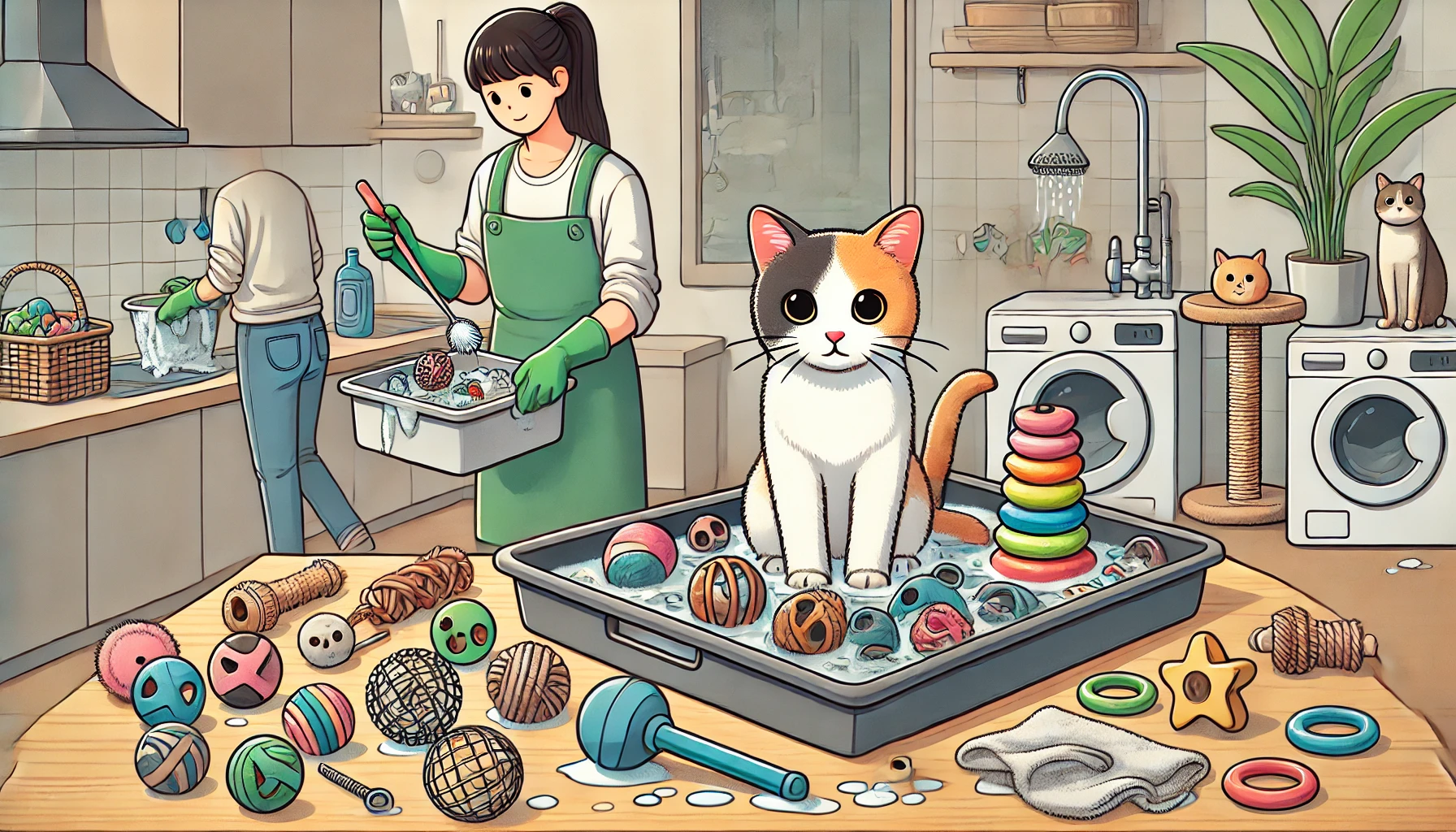
Safety Monitoring and Maintenance of Cat Toys
Ensuring the safety of toys for your cat doesn’t end with the purchase.
Monitoring and maintenance are essential to keeping your cat’s toys safe over time.
Toys can wear down, develop sharp edges, or harbor bacteria that can be harmful to your cat.
Here are ways to make sure your cat’s toys remain safe and in good condition.
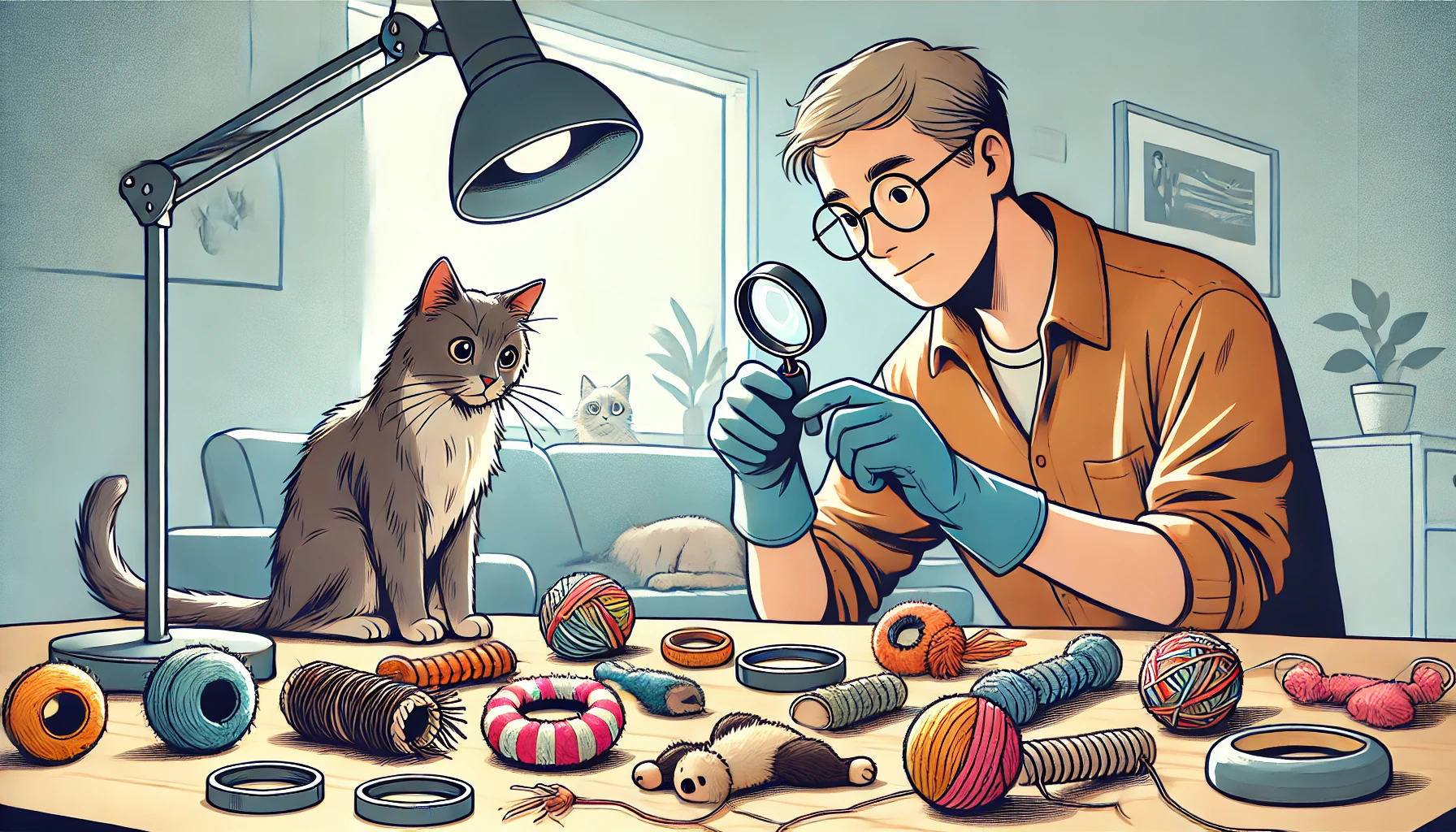
Checking Toys Periodically
It’s a good practice to regularly inspect your cat’s toys.
Damaged toys may pose choking hazards, create sharp edges, or have loose parts that could harm your feline friend.
Look for frayed edges, broken pieces, or missing parts in the toys.
If a toy shows significant damage, it should be replaced immediately.
- Check for sharp or broken parts.
- Look for loose strings or parts that could detach.
- Inspect rubber toys for cracks or holes.
By checking your cat’s toys regularly, you can catch potential problems before an injury happens.
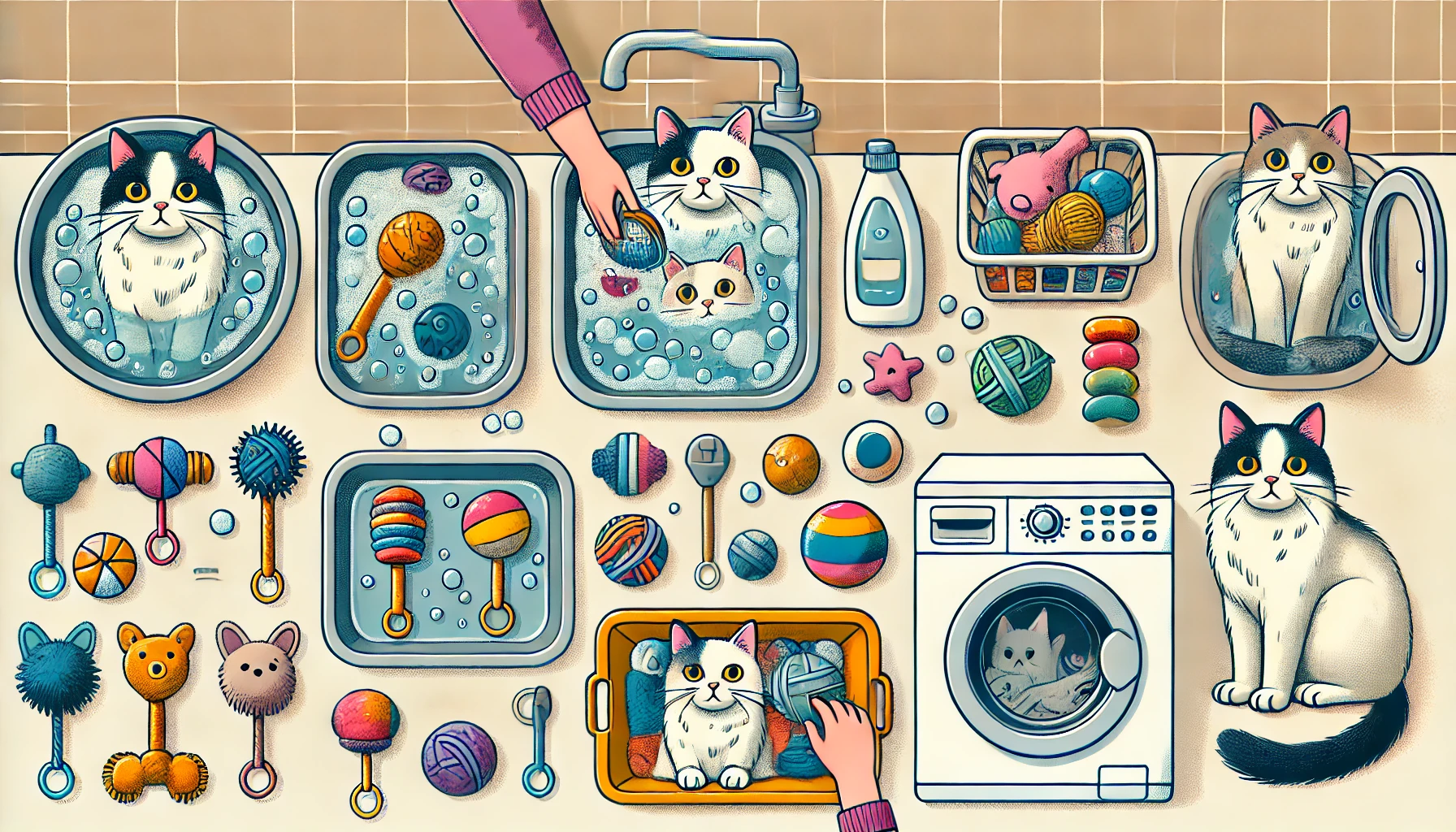
Safely Cleaning Cat Toys
Like any object your cat interacts with, toys will accumulate dirt, saliva, and bacteria over time.
To prevent the buildup of germs that could affect your cat’s health, it’s important to clean toys regularly.
However, different toys require different cleaning methods to maintain the safety of toys.
- Plastic and Rubber Toys: These can usually be cleaned with warm water and mild soap. Be sure to rinse thoroughly to remove any soap residue.
- Fabric Toys: Fabric or plush toys can be machine-washed (if the label allows) or hand-washed. Make sure they are completely dry before giving them back to your cat to avoid mold growth.
- Interactive Electronic Toys: Clean electronic toys with a damp cloth, carefully avoiding areas with batteries or electrical components.
Regular cleaning not only ensures the toys are safe but also prolongs their durability.
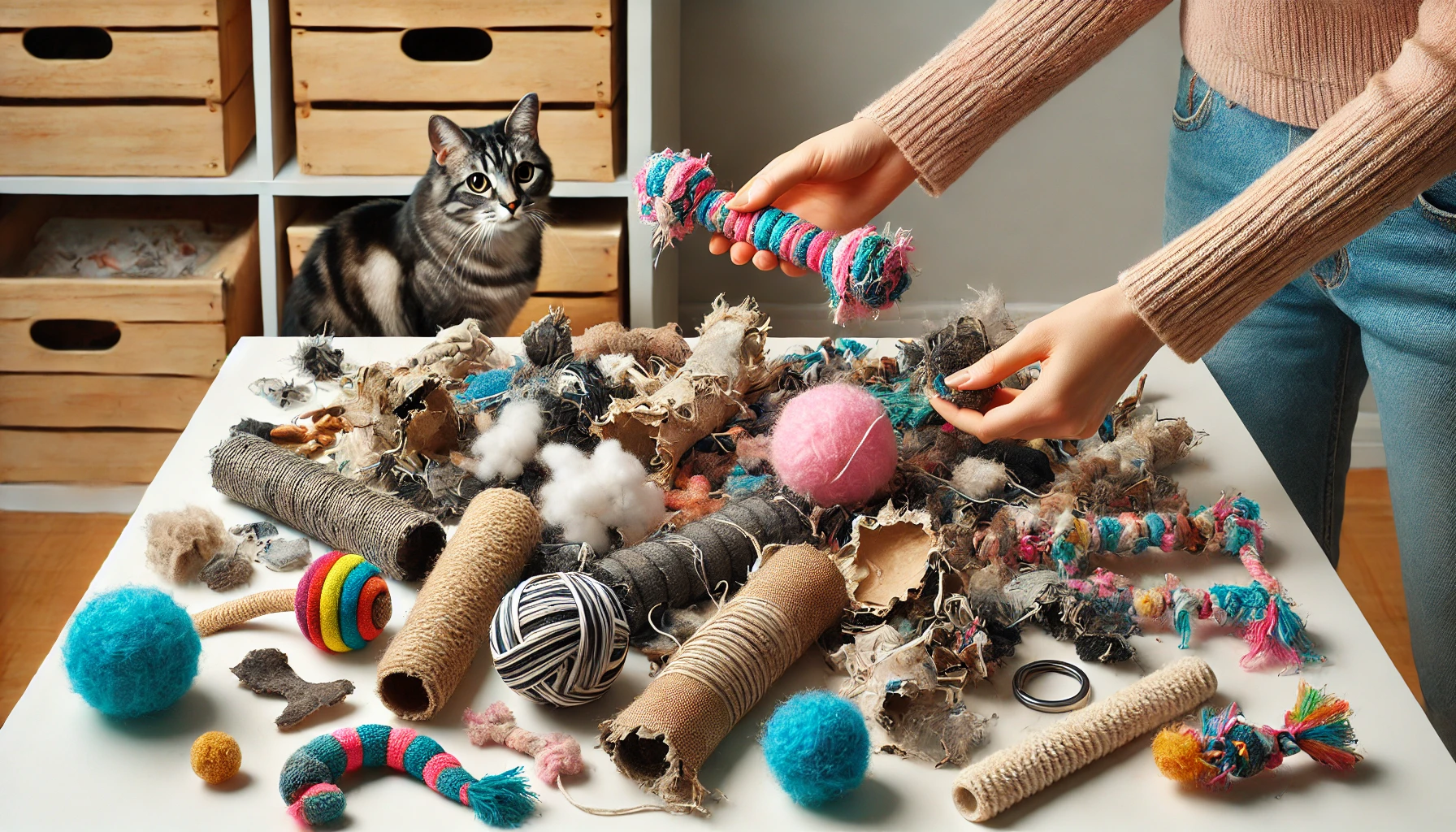
When to Replace Cat Toys
Even with regular maintenance, every toy has a lifespan.
It’s important to know when to retire a toy to keep your cat safe.
If the toy is too damaged or worn down, it’s time to replace it with a new one.
Toys should be replaced when:
- They have sharp edges or exposed stuffing.
- They are falling apart or missing essential parts.
- They are too dirty or smelly to clean effectively.
Rotating old toys out and replacing them with new, undamaged ones will help prevent injuries and ensure your cat always has safe options for playtime.
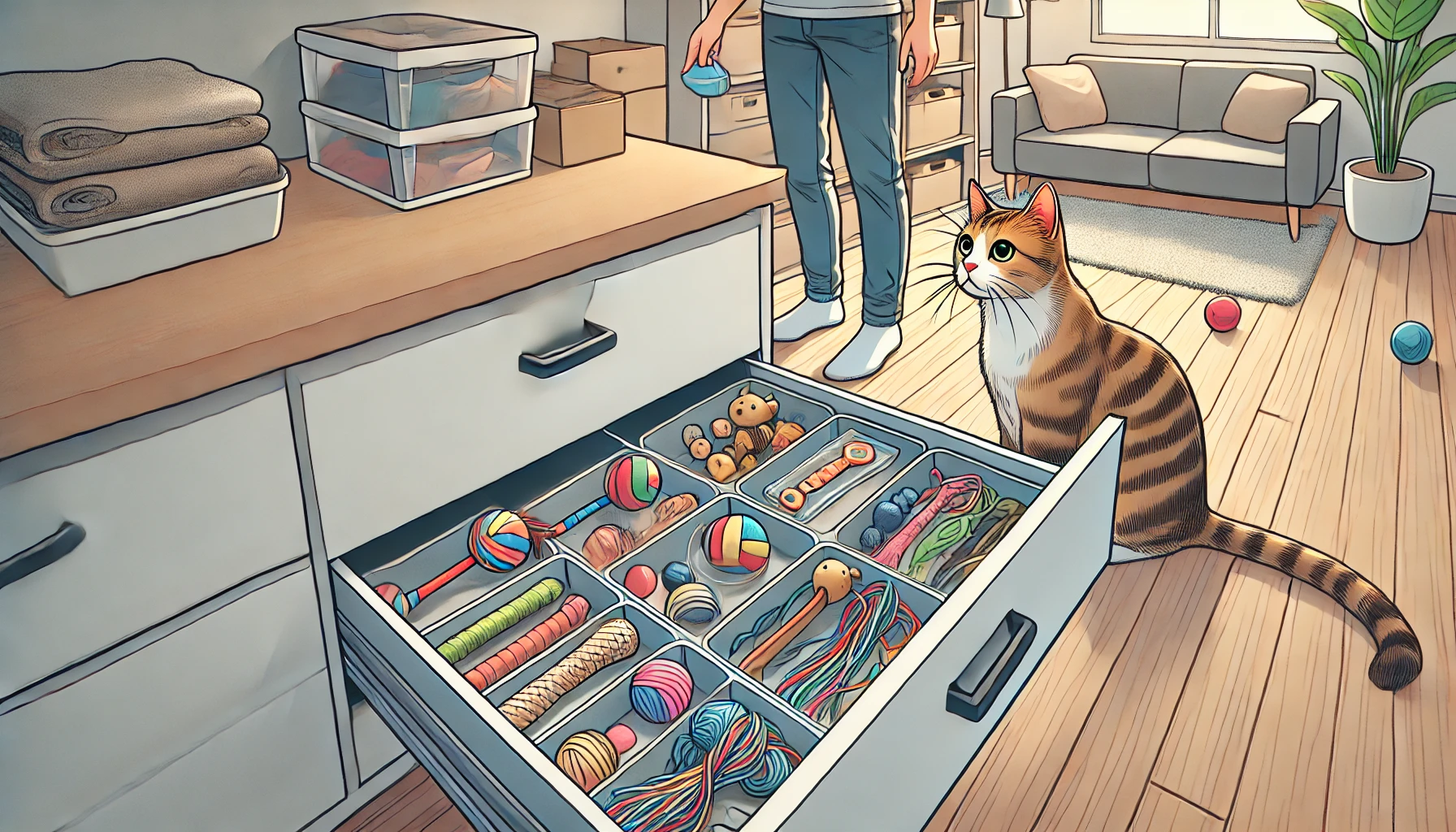
How to Properly Store Toys
Proper storage of your cat’s toys is important for maintaining their safety.
Leaving toys scattered around can lead to unnecessary wear and tear, or your cat might access toys that should only be used under supervision (like string-based toys).
Keep toys in a designated storage box or drawer when not in use.
This will also prevent your cat from getting bored with the same toys, as they won’t have constant access to them.
When you bring them out again, playtime will be more exciting!
By maintaining and monitoring the safety of toys, you ensure that your cat has safe and engaging play while minimizing the risks of injury or contamination.
Regularly check your cat’s toys for wear and tear, clean them frequently, and replace any damaged toys to ensure continued safety.
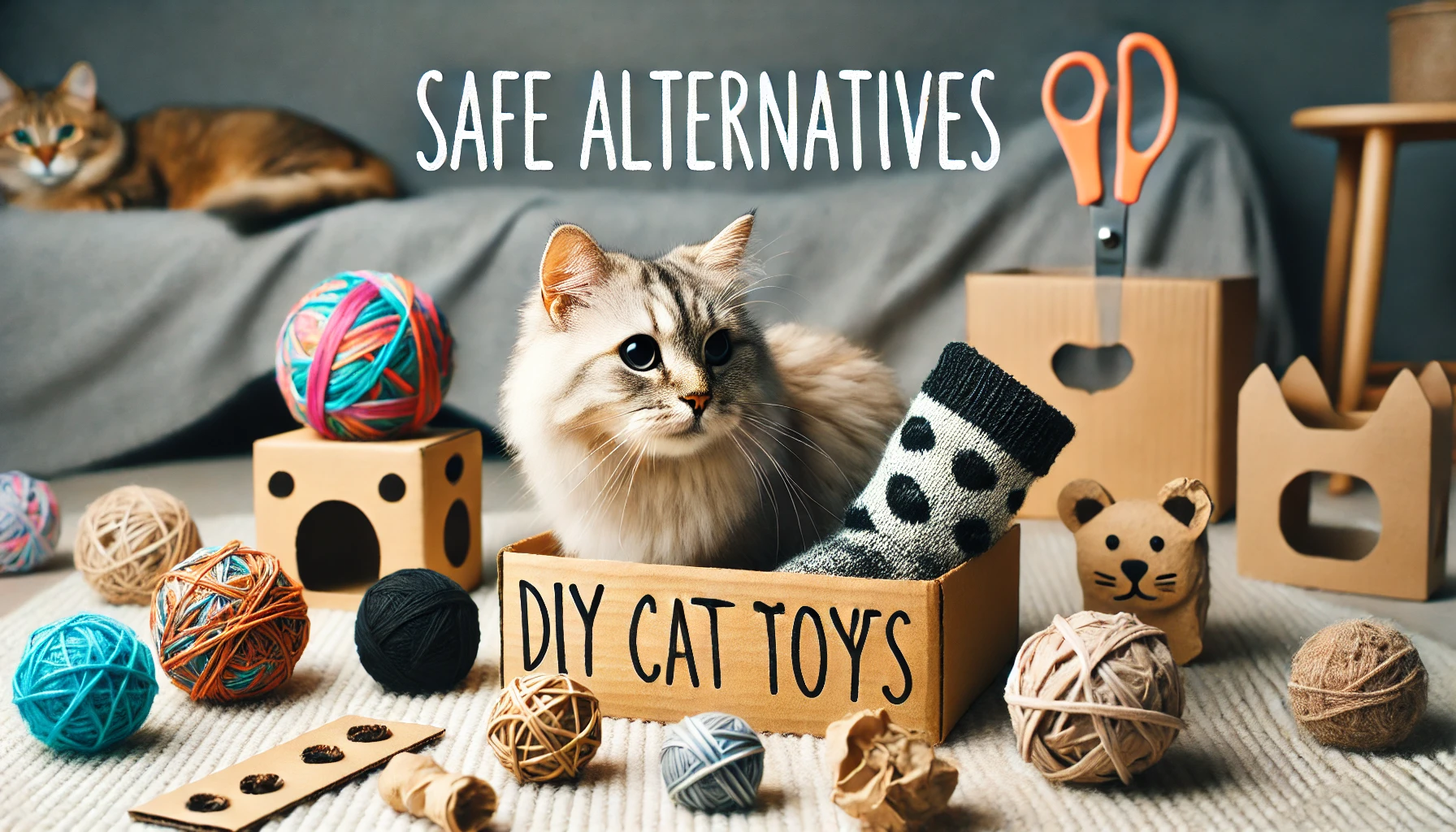
Safe Alternatives to Conventional Cat Toys
While plenty of store-bought toys exist, many cat owners seek out safe alternatives that might be more environmentally friendly, cost-effective, or tailored to their cat’s individual preferences.
These alternatives are just as stimulating and fun but come without the risks that poorly made or unsafe commercial toys may carry.
Let’s look into a few safe play alternatives to common cat toys you can try at home.
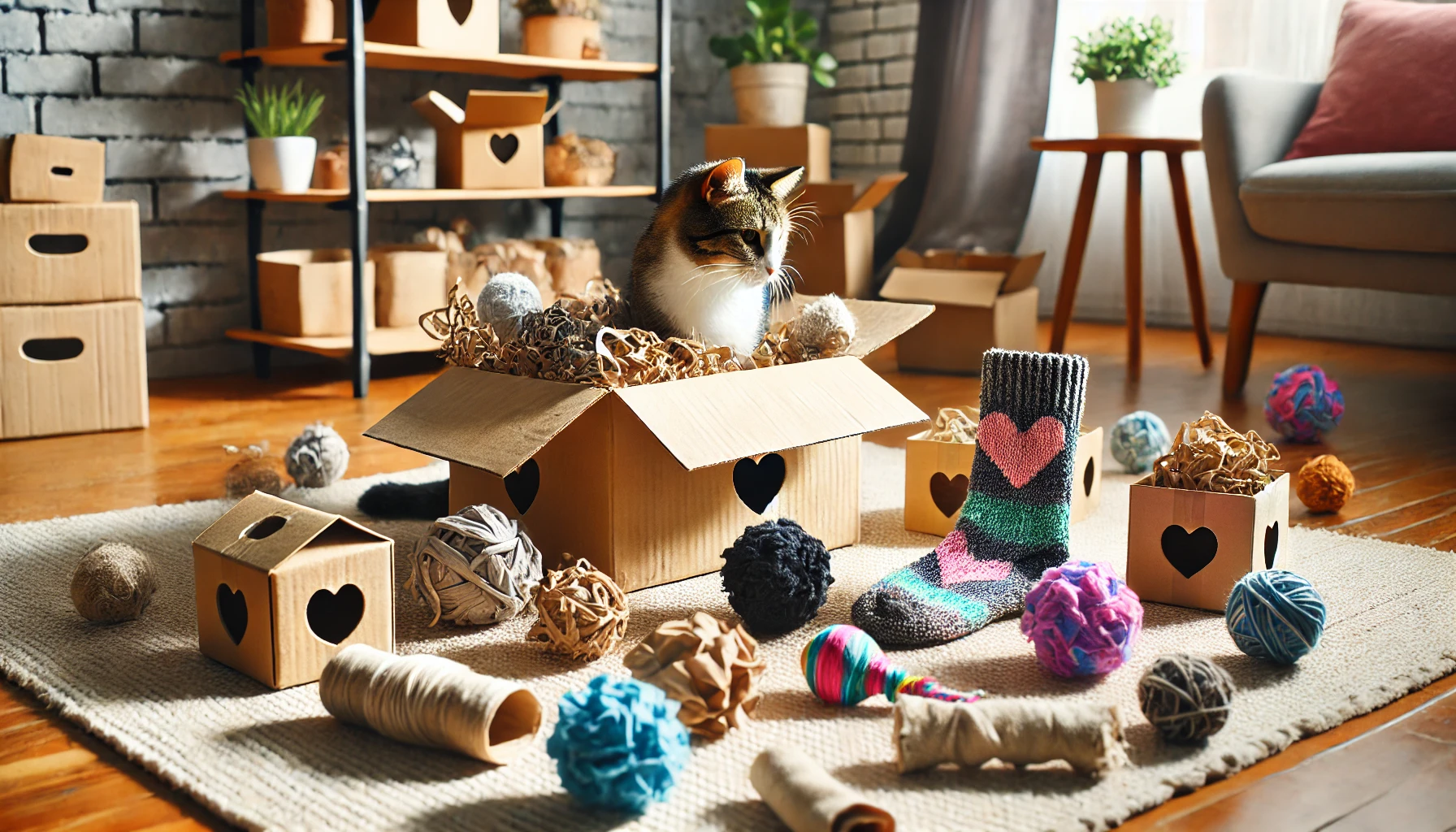
DIY Cat Toy Ideas
One of the most fun ways to ensure the safety of toys for your cat is by making them yourself using items around the house.
DIY toys are often simple, inexpensive, and safe if constructed from the proper materials.
Here are a few ideas:
- Paper Balls: Crumple up some paper into a ball. Cats love lightweight, noisy toys to knock around.
- Cardboard Boxes: A simple box can entertain your cat for hours as they hide, pounce, and explore.
- Sock Toys: Stuff an old sock with either catnip or fabric scraps. Tie it off for a simple, fun toy.
- Toilet Paper Rolls: Empty toilet paper rolls can be stacked or used as tunnels and rolling toys.
DIY toys allow you to have complete control over the materials, ensuring that they are safe for your cat.
Plus, they encourage creativity and can stimulate your cat’s curiosity.
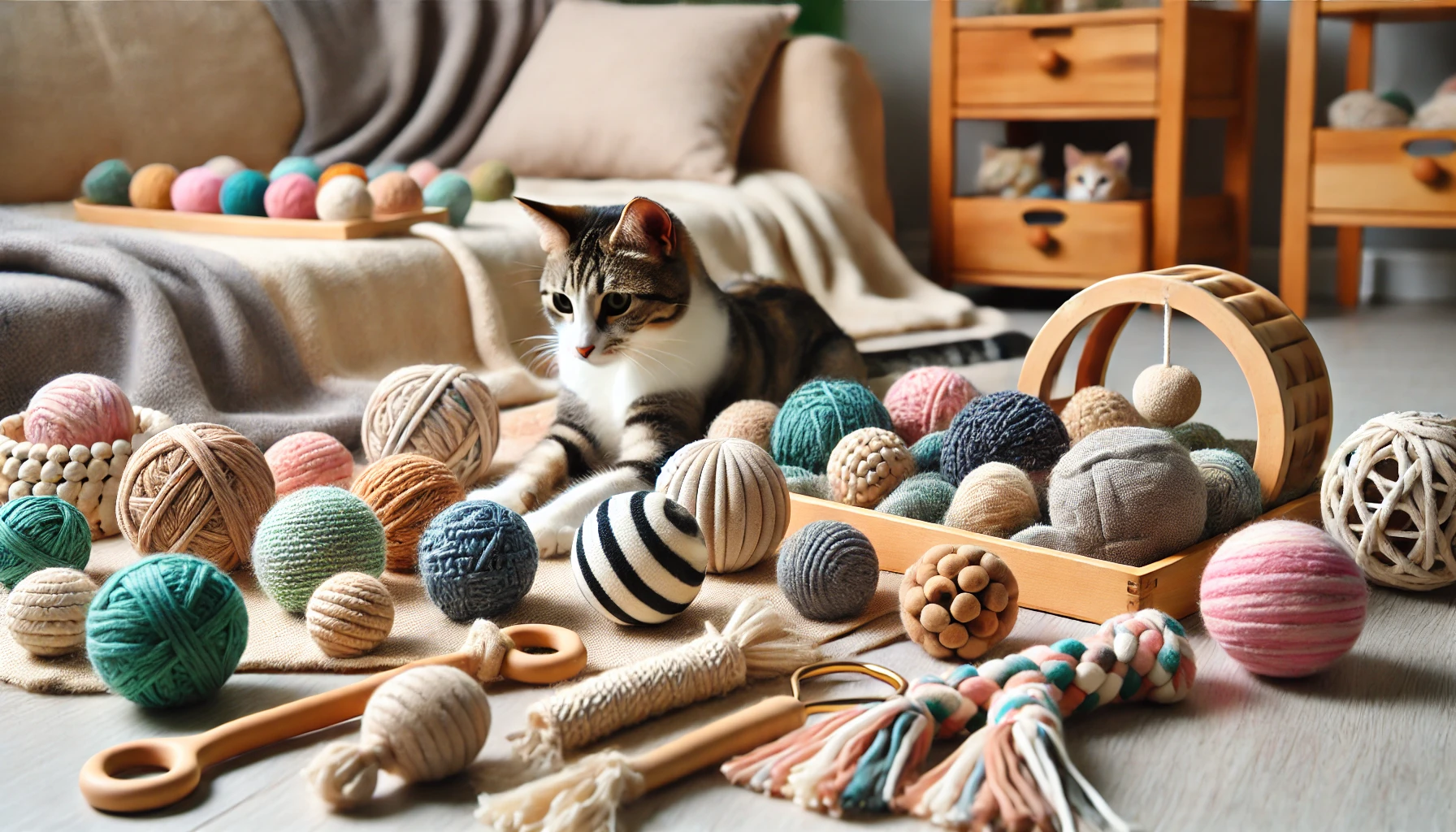
Eco-Friendly Cat Toys
Many cat owners use eco-friendly toys to reduce waste while ensuring their pets play with safe, natural materials.
These toys are often made from biodegradable or recycled materials and don’t contain toxic chemicals or dyes.
Popular options include:
- Recycled Fabric Toys: Toys made from recycled fabrics or felt are soft on your cat’s paws and eco-friendly.
- Natural Wood or Bamboo Toys: These durable toys exclude toxic chemicals, providing safe play for your cat.
- Organic Catnip Toys: Filled with organic catnip, these toys excite your cat while being free of pesticides and harmful substances.
Choosing eco-friendly options ensures the safety of toys for your cat while contributing to a more sustainable environment.
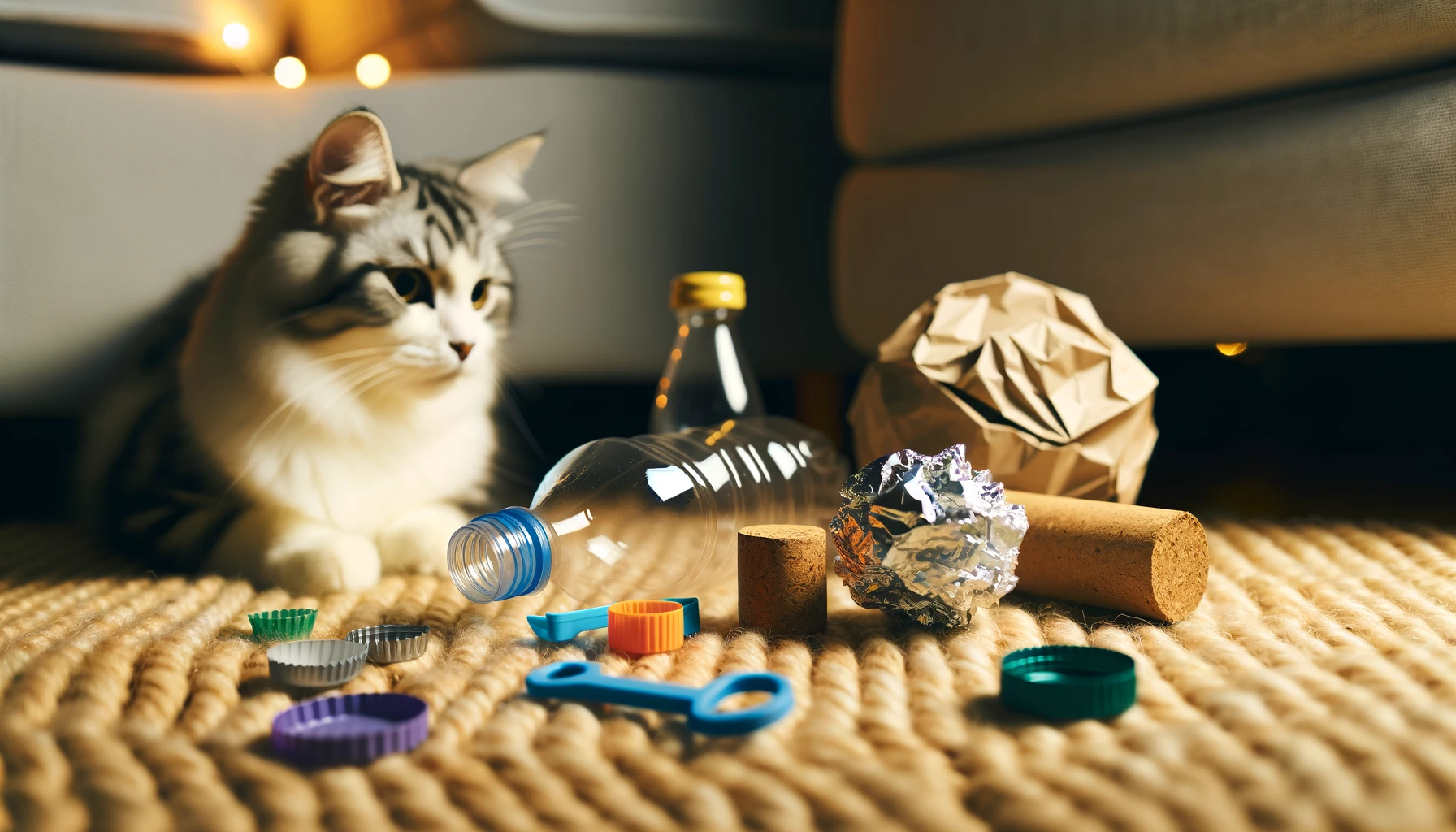
Using Everyday Objects Safely
In addition to homemade toys, common household items can make great and safe feline toys if used properly.
Items like string, ribbons, and hair ties are fun but should always be supervised to prevent choking or strangulation hazards.
Safe household items for play include:
- Wine Corks: Lightweight and fun for cats to bat around.
- Plastic Bottle Caps: These can replace small, detachable toy parts that might pose a risk.
- Aluminum Foil Balls: Rolled-up aluminum foil makes for a fun, crinkly toy.
Always supervise your cat when using household items to ensure they don’t ingest or choke on any pieces.
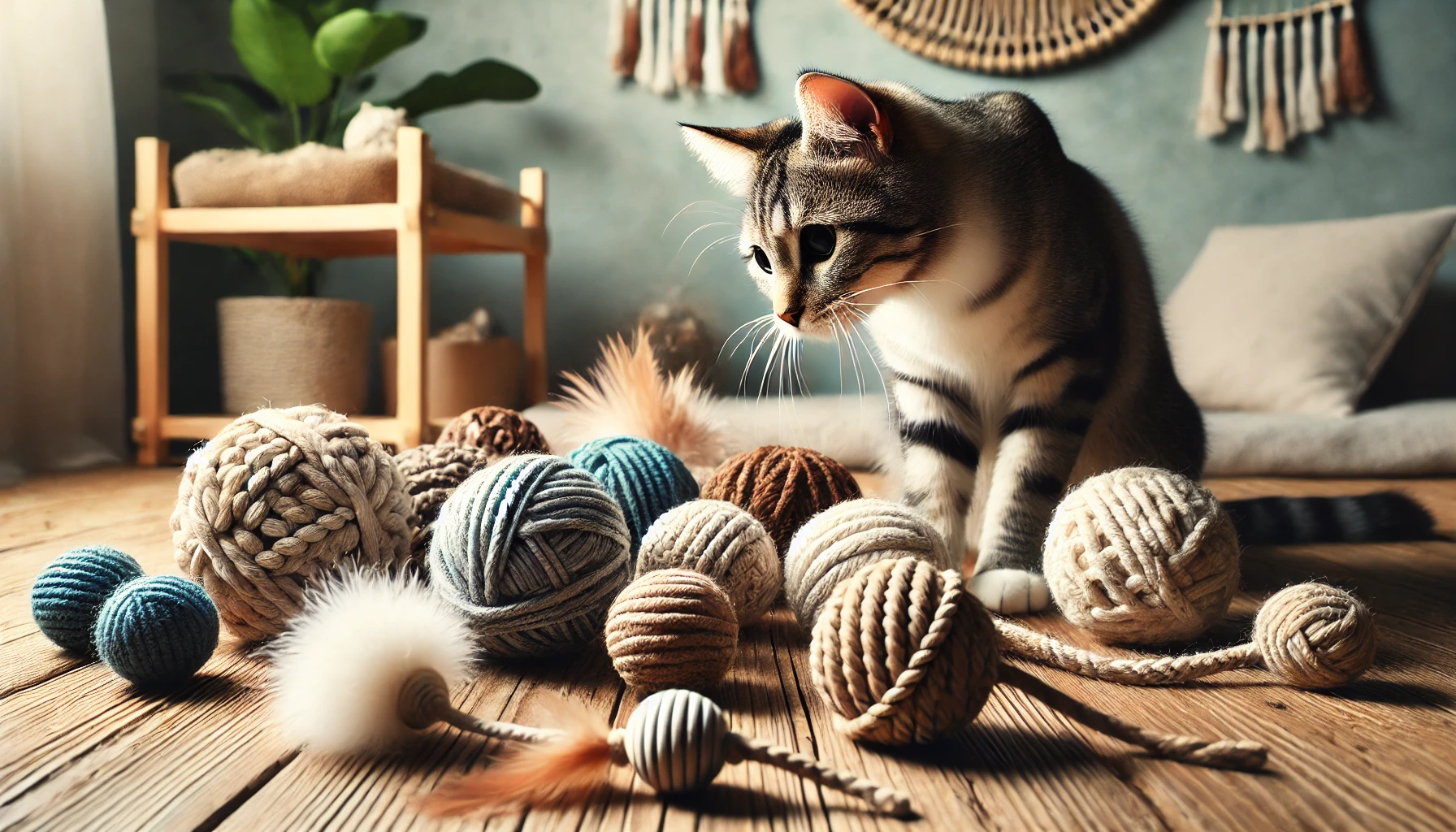
Natural and Non-Toxic Cat Toys
For those concerned about chemicals in their cat’s toys, natural and non-toxic options are the best choice.
These toys are made from organic materials without toxic dyes or synthetic substances.
Popular choices include:
- Untreated Wool Balls: Perfect for cats that enjoy batting soft objects.
- Hemp Rope Toys: Durable and natural, hemp rope toys can be chewed and tugged without posing a health risk.
- Organic Feather Toys: Naturally sourced, untreated feathers are safer for cats that love to pounce and chew.
Natural toys not only provide entertainment but also guarantee your cat isn’t exposed to toxic materials during playtime.
By exploring these safe alternatives to conventional toys, you can ensure your cat stays healthy, happy, and engaged in safe play.
DIY toys or eco-friendly options can provide safe and stimulating alternatives to store-bought toys. Always supervise your cat with new toys, especially those made from household objects.
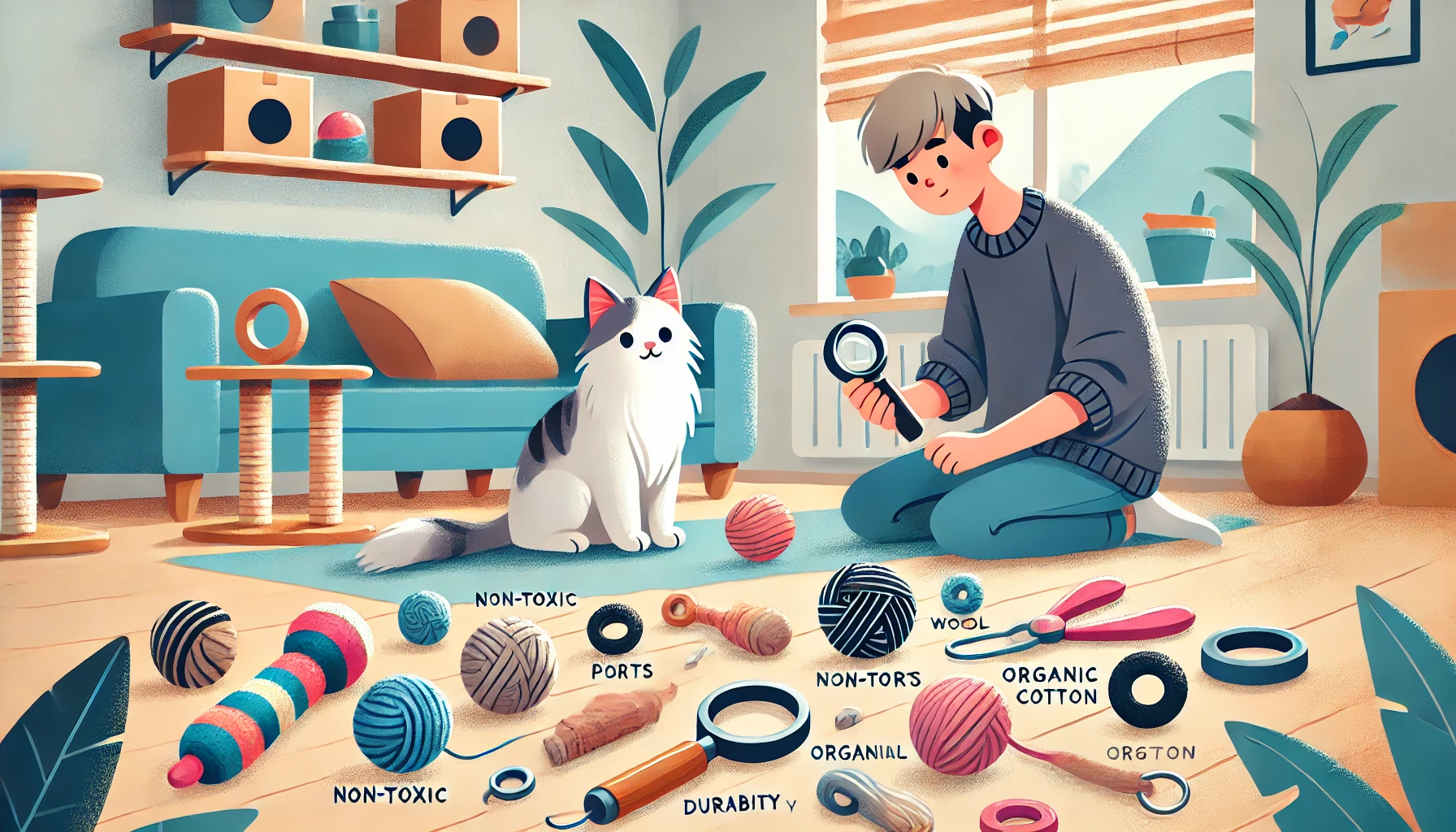
Making Sure Toys Are Safe for Your Cat
As a responsible cat owner, it’s essential to ensure that the toys you provide are safe for your feline friend—whether they are traditional commercial toys or innovative DIY options.
Each decision you make can significantly impact your cat’s happiness and health.
In this article, we have discussed material selection, routine maintenance, and alternative ways to play.
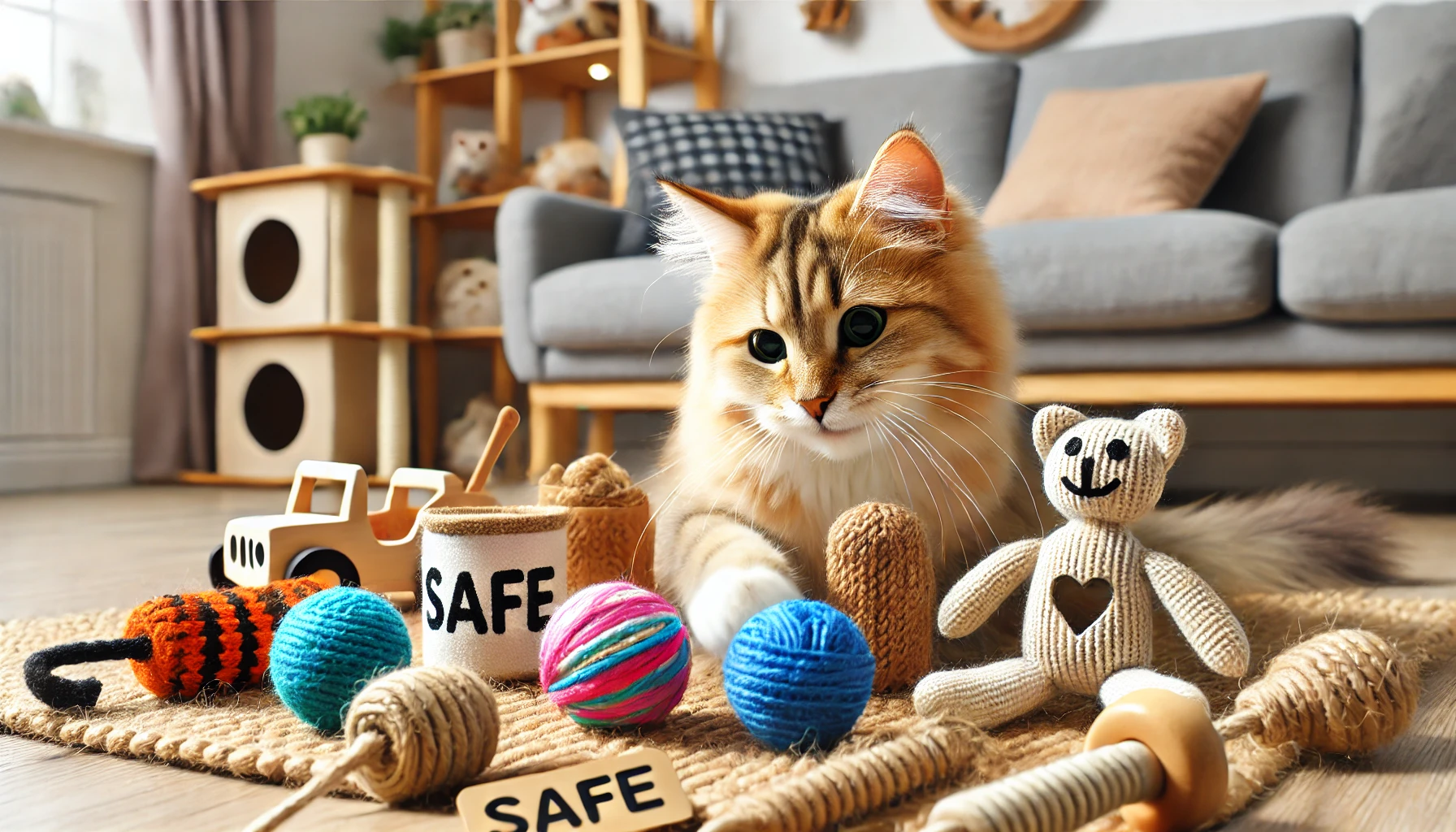
Safety of Toys is Important
Ensuring your cat’s toys are safe is not just about preventing accidents; it’s about creating an environment where your cat can thrive and exhibit healthy play behaviors.
Being proactive about toy safety can help you:
- Reduce choking hazards and other injuries.
- Promote natural play behaviors such as pouncing and chasing.
- Provide mental and physical stimulation.
Implementing these measures will go a long way in improving your cat’s quality of life.
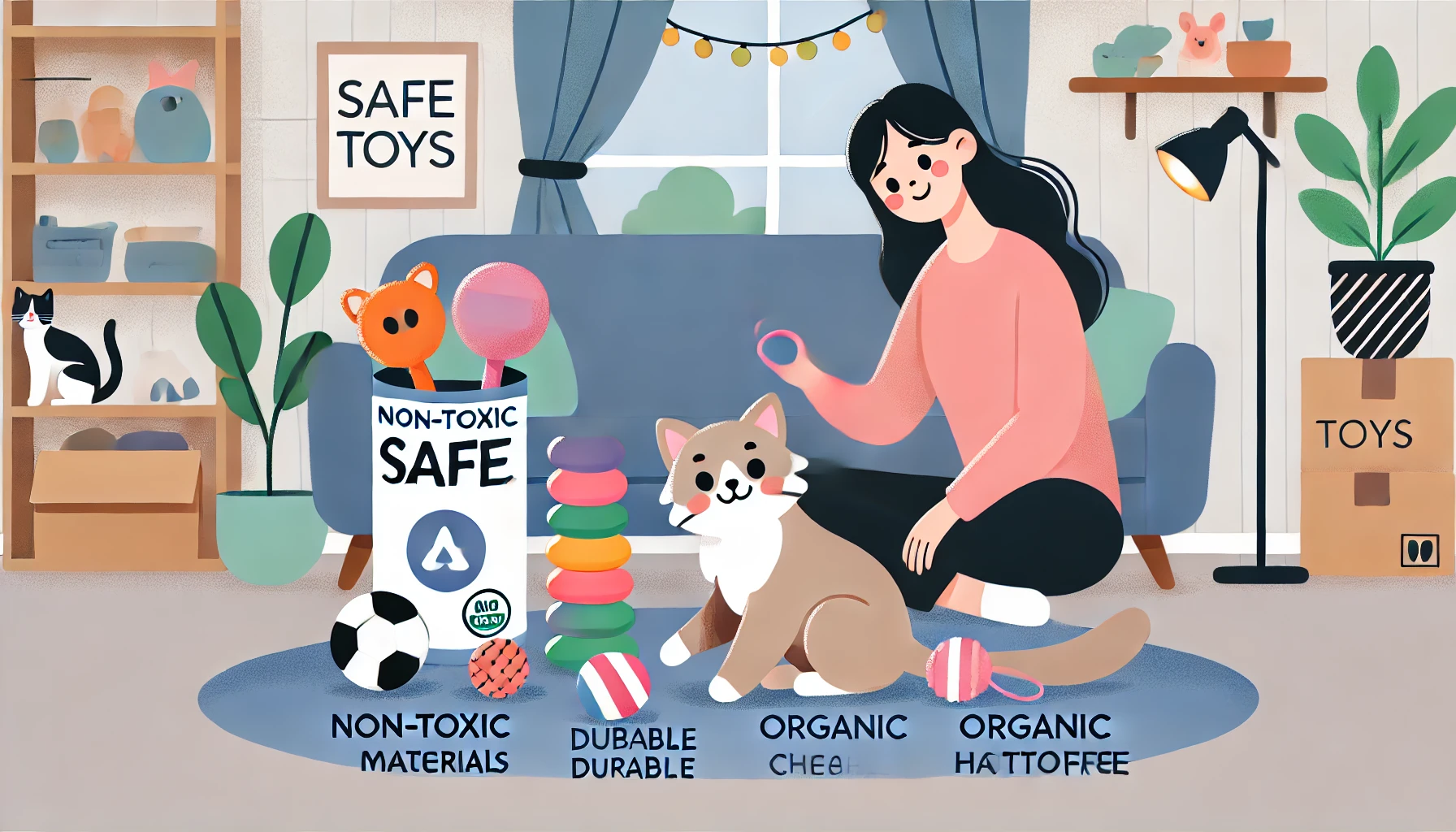
Takeaway Points
Here are a few important things to remember about ensuring the safety of toys for your cat:
- Selecting Toys: Choose toys made from non-toxic and durable materials.
- Regular Cleaning: Regularly check the overall condition of toys to maintain their safety.
- Choking Hazards: Keep in mind the risk of choking and avoid toys with small, detachable parts.
- Homemade Options: Research homemade, chemical-free toys that are both fun and safe to play with.
- Observation: Spend time observing your cat with ordinary household items to determine if they pose any threats.
By combining these tips and ideas into your daily routine, you can ensure lots of fun and safety during playtime.
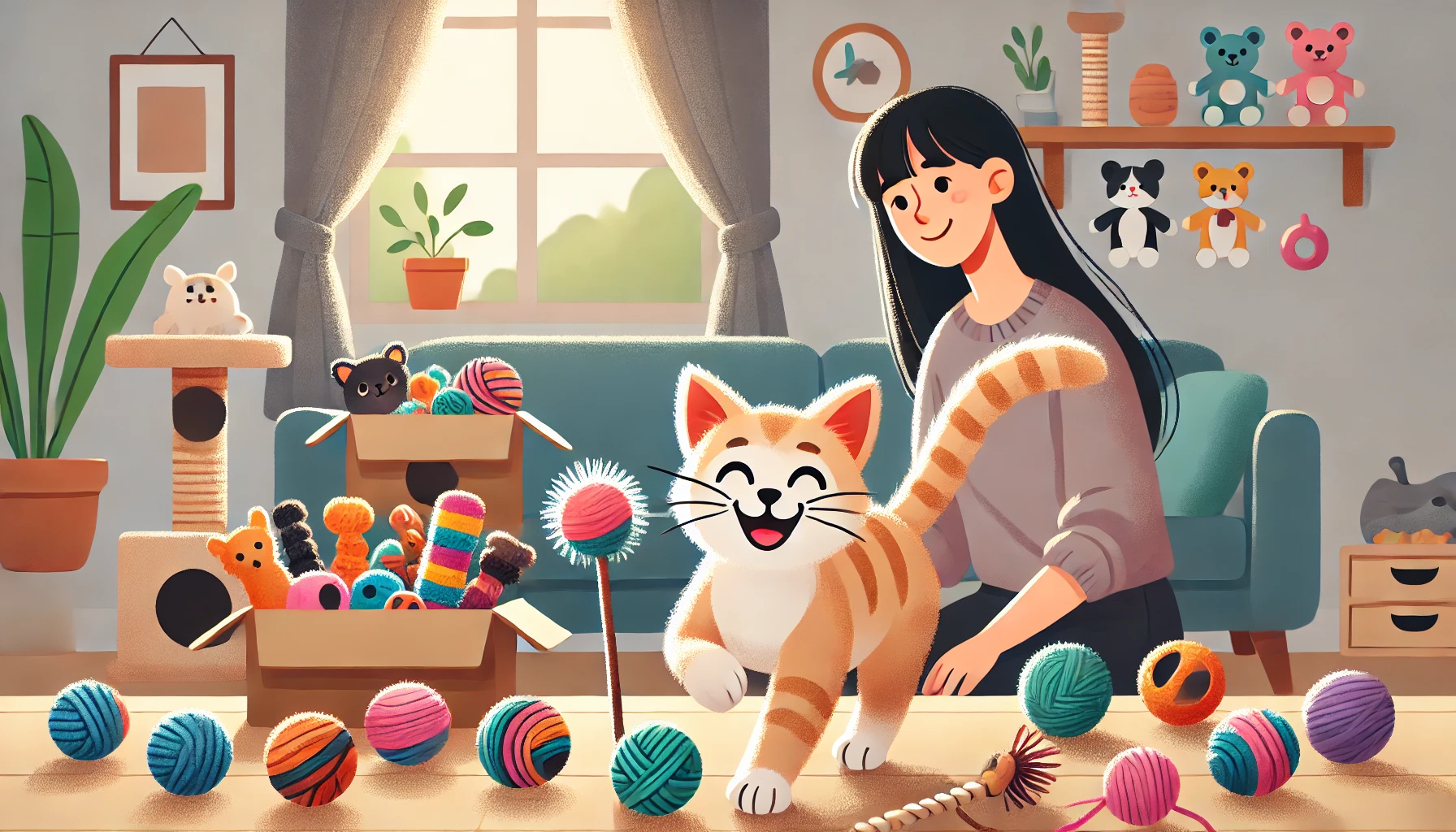
Safety and Fun Conclusion
It goes without saying that the safety of toys is a crucial aspect of your responsibilities as a cat owner.
With the right knowledge and a bit of introspection, you can provide your cat with an enjoyable yet safe selection of toys.
Whether you choose to purchase commercial varieties or take on the fun challenge of creating safe toys at home, your commitment to your cat’s safety and well-being will undoubtedly result in a happier, healthier feline companion.
By regularly inspecting toys, choosing safe materials, and observing your cat’s play behavior, you can ensure the toys remain safe and fun.
Frequently Asked Questions on the Safety of Cat Toys
As a cat owner, you may have several questions about ensuring the safety of toys for your feline friend.
Here are some commonly asked questions and their answers.
How do I know this is a safe toy for my cat?
Look for non-toxic materials, solid construction, and no small removable parts.
Regularly check for wear and tear to ensure the toy remains safe for play.
What materials should I avoid in cat toys?
Avoid toys made from cheaper plastics, synthetic fibers, and toxic chemicals like phthalates, lead, or BPA, as these may be harmful to your cat’s health.
How often should I clean my cat's toys?
Clean your cat’s toys at least once a week to remove dirt and bacteria.
The frequency of cleaning may vary based on usage and the materials of the toys.
Can items around the house be used as cat toys?
Yes, many household items, such as cardboard boxes or paper balls, can be safe and entertaining for cats.
Just ensure they don’t pose choking or injury hazards.
What kind of toys are good for an indoor cat?
The best toys stimulate interaction, like wand toys and puzzle feeders.
For solo play, choose something soft, like a stuffed toy or a ball, ensuring it’s safe and durable.
Is it okay to leave toys out for my cat?
Generally, it’s safe, but rotate toys periodically to keep your cat engaged.
Remove any toys that show signs of damage to avoid safety risks.
What do I do if my cat swallows a part of a toy?
If you suspect your cat has swallowed a part of a toy, contact your veterinarian immediately.
They can guide you on the necessary steps to ensure your cat’s well-being.
Are homemade cat toys safe?
Homemade cat toys can be safe if made from non-toxic materials.
Always supervise your cat and ensure DIY toys don’t have small, detachable parts.
How can I make my own cat toys?
You can create toys using basic materials like paper, cardboard, and fabric.
Just ensure everything is safe and securely constructed to prevent choking hazards.

